Click Here if you listened. We’re trying to gauge interest so only one question is required; however, there is a spot for feedback!
Read along below!
 The Quiet Evolution of Apiary Mowing
The Quiet Evolution of Apiary Mowing
A Necessary Aspect of Apiary Management
By: James E. Tew
My First Real Job
When I was a young teenager, a friend and I would push our mowers around the community and offer to cut grass. We generally earned somewhere between $1.75-2.50 per yard total. We had to split the earnings. The mowers were not self-propelled. Consequently, as young entrepreneurs, we never had a body weight problem.
We developed a regular customer list and at our peak, we were cutting about twenty lawns per week. General expectations were that we cut in straight lines and tips were not offered. When we were thirsty, we drank water from faucets plumbed from the house. Dad provided the mower and the gas, but I was allowed to keep my earnings. Of course, he got his lawn cut for free.
To this day, I cut grass in bullet-straight lines, and I only mow when the lawn absolutely needs it. Now, throughout every Summer month, I marvel at the equipment that professional mowing services have and I compare all that modern equipment to the absolute minimal equipment that my friend and I used all those years ago. Times change, don’t they?
Before Gasoline Mowers
Before gasoline mowers became widely available, lawns were cut using various manual methods and tools. The common methods used for lawn maintenance before gasoline mowers were scythes, sickles, weed slings, grazing animals, manual push mowers and scissors. None of these options were feasible without manual labor. Even grazing animals required fence installation. The invention of gasoline-powered mowers modernized lawn care and made it much more efficient and accessible for homeowners, landscapers and even beekeepers.
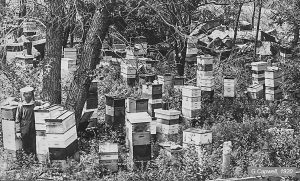
Figure 1. A Kansas beeyard in 1920. Note beekeeper in the lower left of the photo who is wearing a vintage Alexander veil and gauntlet gloves.
What Did this Mean for Apiaries?
It means that our apiaries, decades ago were weedier, and more unkempt by today’s standards. I cannot find information indicating that grazing animals were common methods for foliage management in pre-mower days. No doubt, cows, horses and sheep would occasionally knock over hives or scratch against them.
In the past, all apiary grass and weeds were cut manually requiring hot labor commitments. I’m old enough to remember life before string trimmers and herbicides. Everything was weedier then.
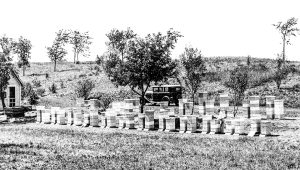
Figure 2. In 1922, in this Iowa beeyard, all grass was cut using manual methods. Gasoline mowers, of the day, were heavy and uncommon.
To Add to the Laborious Task
In years past, just as the present, protective bee gear was commonly worn when cutting and pruning near bee hives. Wearing protective equipment was just as clumsy now as it was years ago. The requirement to wear protective clothing has always made apiary weed control a hot, tiring job. Thankfully, modern protective equipment is better ventilated and more comfortable, but it is still hot work.
No-Mow May
Due to my early years of incessantly cutting grass, as a senior citizen, I am now a reluctant lawn mower. To the chagrin of my neighbors whose lawns are always neatly manicured, I only mow when I must. In this way, I avoid needless mowing sessions and my bees have access to the clover and dandelions in my lawn.
When I first heard of the concept, I readily embraced the notion of a “No-Mow May” in which we just give our lawns a month off from trimming. I quickly found out that a mow-less May lead me directly into a hellish June, with tall grass that frequently required raking after cutting. I had to go back to the lawn maintenance drawing board.
String Trimmers in the Apiary
I don’t remember the first time I used a string trimmer. With my mowing history that I touted before, that memory void seems strange to me. But I do know that a string trimmer became a necessary component of the equipment that always went with me to an outyard. String trimmers are now a common, if unexciting, beeyard management tool. What’s their story?
A Short History of String Trimmers
The history of string trimmers, also known as weed whackers, weed eaters or line trimmers, dates to the early 1970s. The concept of using a rotating nylon string to trim grass and weeds emerged as an alternative to traditional lawn mowers and manual cutting tools.
The concept of a rotating nylon line for cutting vegetation was developed in the late 1960s by George Ballas, a Houston-based entrepreneur. He got the idea while watching the revolving brushes at a car wash (I find this interesting. The common safety razor was envisioned after a visionary watched a woodworker use a common hand plane. The flail honey comb uncapper was conceptualized as another visionary watched the conveyor belt perform at a grocery store checkout. Shouldn’t we all be more observant?). In 1971, he received a patent for his invention, which consisted of a fishing reel with fishing line attached to the spool. Ballas’ invention was the foundation for the modern string trimmer.
In 1972, George Ballas partnered with Jim Goad, an engineer, to refine the design and create the first commercial string trimmer. They established the Weed Eater company and introduced the first gas-powered, handheld string trimmer to the market. This model quickly gained popularity due to its effectiveness in trimming grass and weeds in hard-to-reach areas.
In the late 1970s and early 1980s, electric string trimmers began to appear on the market. These models were lighter and quieter than their gas-powered counterparts, making them more appealing to homeowners with smaller yards.
Bees and Trimmers
No matter how useful power mowers and trimmers may be, on some mowing days, the bees seem to despise them. Most experienced beekeepers have seen this defensive behavior. In fact, common management recommendations warn the beekeeper to expect this attack. It is thought that the odors and vibrations from the mowers and trimmers agitate the bees.
In my own experience gained when trimming around hives, it seems that the bee response is greatest during Summer months when a nectar dearth has ended and the colonies are at full populations.
I have never used a battery-powered trimmer, but I am sure some of you have. I ask if you have noticed less of a response when using battery-powered mowers and trimmers? Does their quietness and lack of fumes have a more lenient effect on the colonies?
Beekeepers and Trimmers
At this moment, I have two, hand-held string trimmers. I have one modified with a cutting blade for heavy or tough growth. Brambles, such as multiflora rose, are a challenge for either type of cutting head.
Even though I frequently use them, I increasingly have issues with string trimmers. The evolving issue is that the older I become, my trimming sessions grow shorter and shorter. My shoulders ache. I get noise warnings from my Apple watch. I get hotter and hotter in the protective gear that I must wear. I simply can’t do the job the way I once could.
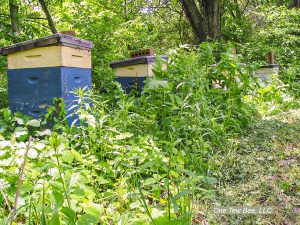
Figure 3. An apiary with uncontrolled grass growth.
Consequently, I have grown to dread the task more and more. All the while, the grass and weeds have continued to grow. Out of necessity, I developed a tolerant attitude of tall grasses and weeds in my apiary. I put my hives on firm hive stands that were twenty inches from the ground and I kept the entrance free of tall weeds. Even then, the grass and weeds in my beeyard continued to grow. My bees seemed unphased by the tall grass in the yards, but increasingly, it became apparent that this approach could not last. Why?
Two reasons that altered my laissez-faire system of yard maintenance evolved. The first reason was you, the reader of Bee Culture articles. Photos and videos that I captured in my apiary looked terrible. For instance, while I wanted to write about a new swarm that I just acquired, my photo of the new bee hive was marred by tall grass and the appearance of a generally unmanaged area. (If you have back issues of Bee Culture, you can readily see these photos.) I grew afraid that you, the reader, would not understand the bigger picture.
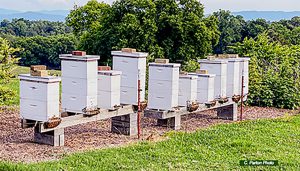
Figure 4. A manicured yard that uses herbicides, grazing animals and electric fencing to keeps foliage at bay. C. Parton Photo
Secondly, the tall weeds made it difficult for me walk while carrying a super of honey or other related bee equipment. Briars tugged at my suit. Tall grass made me stumble as I walked. Grass grew in and around my unused equipment. As with the No-Mow May scenario that I discussed earlier, I had to return to the drawing board. I was physically unable to trim my entire beeyard with a string trimmer and it was too much to ask of my 1972 Snapper push mower to systematically mow this tall grass.
A Heavy Duty, Walk-Behind Trimmer
I would occasionally see advertisements for various models of walk-behind trimmers. I asked around my circle of beekeeping friends, but no one had experience with these machines. I checked online. Yes, wheel kits were available for my string trimmers. In theory, I could modify my handheld trimmers to be mobile. Again, I asked around my circle of beekeeping friends, but no one had experience with these wheel kits either. All the while, the grass continued to grow. Would a trimmer on wheels allow me to work longer and more consistently?
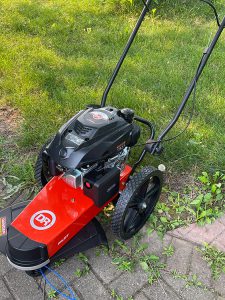
Figure 5. A walk-behind Cord Trimmer.
In mid-July, with apiary grass higher than my knees, I broke. This situation in my apiary was unacceptable and was never going to get better. I went to an equipment dealer to buy a wheel kit. They did not have one, but they did have a single walk-behind trimmer on the showroom floor. It was $400. I bought it on the spot. It uses four .175” spiral cutting cords and cuts a twenty-two-inch swatch. It cuts at five heights – from 1.5” to 3.5”. I set it to the highest setting. The machine fairly easily chewed through the tall weeds leaving me with a somewhat rough-looking finished job, but the weeds were readily cut down.
The nose on the machine does a reasonably good job of getting beneath my hive stands – not perfect – but reasonably good. The cords are not cost free and they do wear out, but the machine aggressively took out tall weeds. It worked.
The major drawback is that I must still push the machine through tall grass. That requires old fashioned perspiration, but it’s still easier than using a handheld string unit. Please know that I am not selling these units. I’m only looking for a yard maintenance remedy.
For beekeepers younger than or more physically fit than I am, a typical string trimmer would get the job done. As I have written in previous articles, I’m at a stage of my beekeeping where I try to put wheels on everything. String trimmers were no exception. I should also say that while the bees didn’t go crazy, I still needed to wear light protective gear when using the machine.
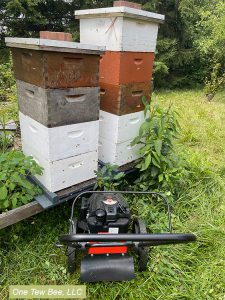
Figure 6. Weed whacking beneath hives.
Hot and Clumsy
This past July 2023 was the hottest July every recorded. Yet the grass kept growing. To keep the grass under control, grass-cutting beekeepers are hot, and clumsy, and are surrounded by irate bees. Can it get any worse? Yes, it can, at the same time, we are also using power mowing equipment. Occasionally, accidents happen. This is a beekeeper’s recent story.
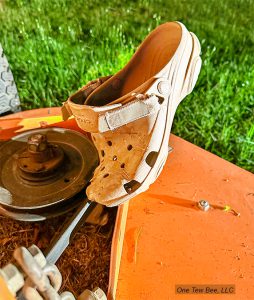
Figure 7. Accidents happen quickly. Attacking bees can be distracting. Many of us have a story.
I got home from work and my wife wanted to cut the grass but she’d never used that particular riding mower. I changed out of my work boots into my Crocs and pulled the mower out of the garage for her. I decided to make a couple passes by my bee hives so my wife wouldn’t get stung.
My bees have never bothered me before. On the first pass, I had hundreds of bees come after me. They were stinging me so much that I was fearful I might have an allergic reaction. I quickly decided to jump off the riding mower and make a run for the house. My foot got caught in the pulley and belt on the mower deck. My croc stayed lodged in the mower belt while I ran into the house. When I got inside and got all the bees off me, I realized how badly my foot was hurt.
I went to the Emergency Room where they said it had broken my toe and cut a tendon. It almost cut my toe off. I had 12 stitches and had to wear a Draco shoe that keeps the weight on my heel and off my toe until my broken toe can heal.
Mowing is Not Beekeeping
Every apiary mowing situation is different but presently, we have an abundance of diversified mowing devices. That selection of devices does not mean that mowing is not hot, demanding work. Don’t go crazy cutting grass and weeds, but when you do mow, I would suggest wearing heavy shoes and a ventilated bee suit with a veil that opens to allow for water sips. Have a lit smoker at the ready. Mowing is not beekeeping. Pace yourself.
Thank you.
I appreciate you reading and sending any comments that you may have. Your time is valuable. I know that.
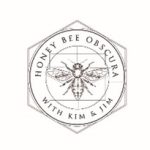 Dr. James E. Tew
Dr. James E. Tew
Emeritus Faculty, Entomology
The Ohio State University
[email protected]
Co-Host, Honey Bee
Obscura Podcast
www.honeybeeobscura.com
Click Here if you listened. We’re trying to gauge interest so only one question is required; however, there is a spot for feedback!
Read along below!
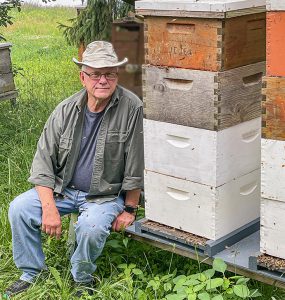 My Apiary Ecosystem
My Apiary Ecosystem
Honey bees are only a part of it.
By: James E. Tew
There’s always going to be something
In my hives or in my life, there is always going to be something – some issue or some problem. I literally just finished a phone call with one of my adult daughters. She had just eliminated a harmless Wolf Spider (Tigrosa annexa) because it frightened her young son (my nine-year old grandson). A few weeks ago, she had a problem with ants in her kitchen, but now they are gone. Now, she has Springtails (Collembola) in one of her bath showers. She complained to me that she feels that her home is under constant attack. I tried to tell her that there is always going to be something going awry. Always. Chill out. I don’t think she listened to me, but I listened to her.
Since I have spent my adult life studying honey bees, she assumed that I was also an information resource for Springtails. Readers, I don’t know anything about these small flea-sized arthropods, but unintentionally, my daughter set me to thinking and exploring. What do I know about Springtails? In all my beekeeping years, I have never asked or thought about the presence of Collembola in bee hives.
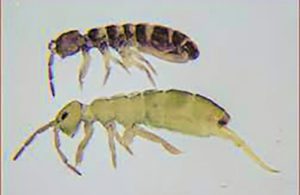
Figure 1. Springtails are about the size of a flea and seemingly cause no harm to bees or beekeeping.
Springtails are common in organic materials that are being degraded. On a whim, I keyed in a web search on Springtails (Collembola) in bee hives. I immediately got hits. All the citations that I found were from observant beekeepers. Having not found any information from academic or regulatory sources, I went to an AI open-source app and was given the following, undocumented information.
Collembola, commonly known as Springtails, are small arthropods that belong to the class Collembola. They are found in a wide range of habitats, including soil, leaf litter and decaying organic matter. While they are not typically associated with bee hives, it is possible for Springtails to be present in bee hives under certain conditions.
Springtails are detritivores, meaning they feed on decaying organic matter and microorganisms. In a bee hive, there may be small amounts of organic debris, such as pollen, beeswax and other residue, which could provide a food source for Springtails. However, the presence of Springtails in a bee hive is usually considered incidental and not a significant problem for honey bees.
I had no idea
I had no idea that these small animals could occasionally be found in hives, but my conversation with my daughter came at a time that I had been pondering this very concept. What is routinely in my bee hives and in my apiary other than honey bees? I have never found a comprehensive listing of the lifeforms that I could expect to find there.
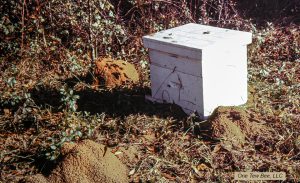
Figure 2. Fire ants and my honey bees. Do the ants help or hurt my bees? Ants, of many species, are common in my beeyard.
My apiary is essentially a distinct ecosystem. My apiary is where I keep my bees, but I have long since realized that many other species find that an apiary is home for them, too. These “unknowns” can apparently fall into three broad categories: harmful, beneficial or neutral.
The Big List
Early in our beekeeping journeys, we are exposed to what I have named the “Big List.” Some of the common entries on this list are raccoons, skunks, ants, wax moths, small hive beetles, birds, toads and mice. It is not my intent to discuss these common hive intruders here. Yet, in the hours and hours that I have either sat by my colonies or pawed through them, I routinely see other species and wonder what they’re up to as they bum around my hives. Usually, their presence remains a mystery.
Flies
Of course, there are numerous species of flies in and around my hives and colonies. We’ve all seen them. In fact, the classic book, Honey Bee Pests, Predators, & Diseases (Morse, Roger A. & Kim Flottum. Honey Bee pests, Predators, & Diseases. A.I.Root Company, Medina, Ohio. 44691. 718 pp. Chpt 8. P 143-162.) has a designated chapter on various fly species and their effects on bee colonies. Essentially, flies and their associated larvae are degraders and generally, do not have a harmful effect on healthy bees.
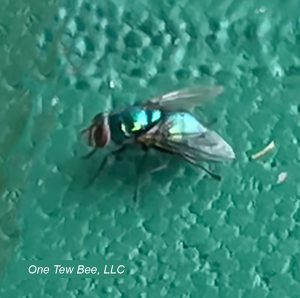
Figure 3. Common Green Bottle Fly (Blow Fly), probably Lucilia sericata, parked on the front of one of my active hives.
But, I can’t help but notice the occasional Green Bottle Fly nosing around my active hives. They are very flighty and will not allow a close camera shot before taking quick flight. Why are they there? I never see them get inside the hive.
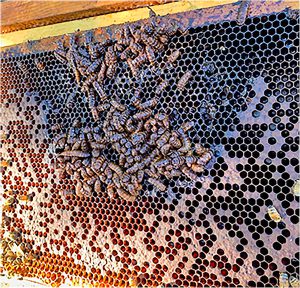
Figure 4. Black Soldier Fly larvae, H. illucens larvae, on honey bee frame. (Scott Razee photo)
But there are unique encounters between various Dipterous species and honey bees that are rare. Anthony (Auth, C. Anthony, Hauser, M. & Hopkins, B.K. A scientific note on a black soldier fly (Stratiomyidae: Hermetia illucens) infestation within a western honey bee (Apis mellifera) colony. Apidologie 52, 576–579 (2021). https://doi.org/10.1007/s13592-021-00844-y) published a scientific note on a Black Soldier Fly (Stratiomyidae: Hermetia illucens) infestation within a western honey bee (Apis mellifera) colony. In the article abstract, Anthony, et al. reported:
Black soldier Fly larvae (Hermetia illucens) were discovered in a weak honey bee colony in Hailey, Idaho. The larvae were localized to the brood area and caused the affected comb to putrefy. Further communication with the beekeeper revealed that the colony recently returned from California and that the larvae likely originated there as well. In California, H. illucens are common and exist sympatrically with honey bees, yet there have been very few reports of damage. We therefore believe H. illucens are unlikely to cause damage to healthy colonies or significantly impact the apiculture industry. This report is the first published observation of H. illucens in Idaho and shows conclusively for the first time that H. illucens associates with honey bee colonies in North America.
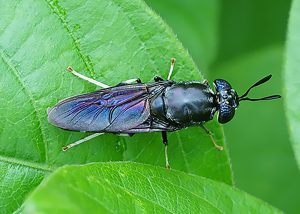
Figure 5. Adult Black Soldier Fly (Utah State University Extension)
There are distinct Diptera species that either are outright harmful to bees or other flies that are considered to be minor pests. Examples of damaging species are Phorid Flies (Zombie Flies) while a lesser pest is the bee louse (Braula caeca). These pests are documented elsewhere in the beekeeping literature. I will not cover them here.
Earwigs
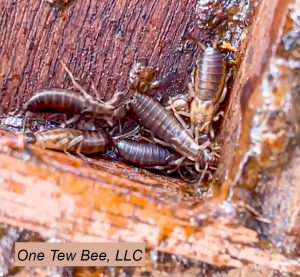
Figure 6. Adult European earwigs on the inner cover of my hive.
How bad can earwigs be? In Alabama, earwigs are commonly found in honey bee colonies in significant numbers. No doubt they are found in other states. I have noted that earwigs were not a common hive resident in Ohio, but that all changed a few years ago. I now have earwigs in my office, in my home and in my bee hives.
I don’t know that they do anything within the hive. I faintly remember one Russian paper, that reported that earwigs could be alternate hosts for the bacteria causing European Foulbrood. Other than that one point, I have never heard complaints about them.
Of course, they are a pain when extracting and must be caught in the filter when processing honey. Straining bees and bee parts from honey is bad enough, but earwigs in the honey filter are unsightly. I don’t know of anything that you can do about them. In fact, I’m not sure anything should be done about them.
Roaches
As an entomologist, I respect roaches. They are the consummate survivor. Obnoxious that they are to humans, one must respect their persistence. Many, many developmental years ago, roaches “learned” to fold their wings over their bodies so they could exploit more niches, than say, a broad-winged insect like a dragonfly (dragonflies will also occasionally prey on honey bees). By storing their folded wings over their bodies, cockroaches could, more easily, get under your refrigerator or inside your bee hives. They have been a challenge for me everywhere I have kept bees.
Like so many other insect visitors/invaders, roaches are drawn to both the sweet food supply as well as the protein supplies – and then there are all the decaying larvae and adult bees to munch on. The question is begged, “Why would roaches NOT be in our hives and stored equipment?”
In the beekeeping literature, it is often written that the damage roaches do is minimal, but I want to loudly say that the appearance of just a single roach in your honey house can dissuade even the staunchest customer who is considering buying your honey. And then there is the excreta to consider. In fact, one of my most serious concerns of both cockroaches and earwigs is the excrement that they leave behind.
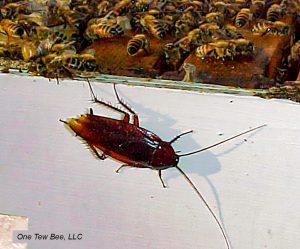
Figure 7. Unfortunately, a cockroach is not an uncommon hive visitor.
It is also commonly written that cockroaches are primarily found in weakened or otherwise ailing colonies. Yes, that is surely true, but I will loudly say that great numbers of roaches happily live on the inner cover of populous colonies. When the outer cover is removed, in a flash, they scamper down into the bees.
In my opinion, there is little to be done to control a roach infestation. Protecting the customer and protecting the purity of the honey product is about all that can be done. Yet, I cannot conclusively say that a modest roach infestation is absolutely harmful to the bees. Maybe future studies will continue to add information to this colony co-habitant.
Honey Bee Cousins
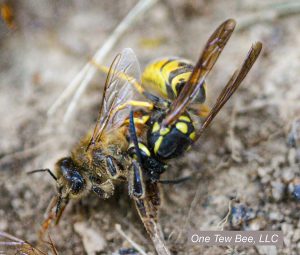
Figure 8. A yellowjacket lunching on one of my dead honey bees.
Yellowjackets
Though yellowjackets are on my “Big List” and are common pests in the beeyard, I have included them here. In my yards, these brightly colored insects could almost be a traditional resident of my apiary. Yellowjackets get included on my “mystery” list due to technicalities.
Yellowjackets (probably Vespula maculifrons) readily see their honey bee cousins as a potential food supply. On occasion, these wasps may have a nest in my apiary, but much more likely is that these hymenopterous insects are simply foraging within my apiary.
Experienced beekeepers have commonly seen yellowjackets mulling around the detritus at the hive entrance, but they will also enter a weakened colony and take honey, pollen, brood and adults depending on their own colony needs.
As such, yellowjackets get an entry on the common list of bee colony pests, but they do not seem to be the effective cause of the colony’s decline but are more commonly responding to a colony that has been weakened by other factors. Yellowjackets can be numerous when robbing behavior is rampant.
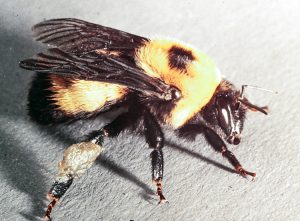
Figure 9. Bumblebees can frequently be seen attempting to enter a honey bee colony. This can be disastrous for the bumblebee with deadly results.
Bumblebees
I frequently see bumblebees trying to enter a bee colony. How suicidal is that? Only on a few occasions have I stumbled onto a bumble nest in unused honey bee equipment, but they are frequently in my apiary surely searching for food.
In fact, bumblebees may not necessarily be attracted to my honey bee colonies specifically, but they may be drawn to certain characteristics or resources associated with honey bee colonies. I can come up with a few reasons that may explain why bumblebees are sometimes found near my honey bee colonies:
- Floral resources: Honey bee colonies are known to forage on a wide variety of flowering plants to collect nectar and pollen. Bumblebees, like honey bees, are also generalist foragers and seek out similar floral resources.
- Odor cues: Honey bee colonies emit a combination of pheromones and odors that can be detected by other bees, including bumblebees. These chemical signals may serve as attractants, potentially drawing bumblebees to the entrance of the honey bee colony.
- Nesting opportunities: While honey bees typically nest in enclosed structures such as beehives or tree cavities, bumblebees often create nests in the ground or other protected locations. However, bumblebees may occasionally take advantage of abandoned honey bee hives or other suitable cavities near a honey bee colony, which could lead to their presence in the area.
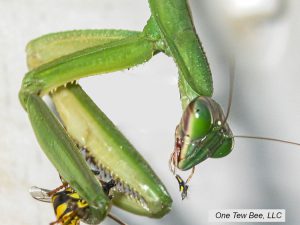
Figure 10. The apiary ecosystem can become complicated. This mantis is eating a yellowjacket that it caught while sitting atop one of my hives.
It’s important to note that interactions between bumblebees and honey bees can vary depending on the specific circumstances and the behavior of individual bees. While they may coexist peacefully in some cases, competition for limited resources, like nectar or nesting sites, can also occur.
My core point for this article
The apiary is an active place, but not only for honey bees. Many other common and not-so-common insects and animals hang around the beeyard foraging for food or shelter. You and I take a staunch view of these unwanted visitors. But truthfully, we do not know a lot about the complex interaction between all these other species and our honey bees.
For instance, Caron (Caron, Dewey. In Honey Bee Pest, Predators, and Diseases cited elsewhere in this article.), listed more than fifteen different beetle species that could be found in beehives – usually in the bottom board litter. Most beetle species had no ill effect on our bees, but I can’t help but wonder if some of those species could be beneficial to our honey bees. Currently, no one seems to know.
In this article, I have only tinkered with a few of the species that we can see with our unaided eyes. I made no effort to review the macroscopic visitors. Examples are: protozoans, fungi and nematodes. They’re all there, too. Readers, I sense that I’m describing a bee hive supermarket or maybe a big box store for insects.
Not wanting to run amok here, but it appears to me that the apiary is a significant food and shelter resource for a lot of other insects and animals. As beekeepers, we laud the effectiveness of the workers’ defensive stinger, but this protective device does not seem to be very effective against spiders, earwigs, birds or a fungus particle. I’m guessing that out of simple necessity, bees coexist with many of these interlopers. Hive visitors come in differing sizes and represent many diverse species.
Despite everything the bees and their keepers can do, the apiary will seemingly continue to be an attractive site for non-bee species. In this article, I’m trying to ask, “From a diversified ecological position, is this necessarily a bad thing?” Consider how many other species are being subsidized and nurtured by resources from our apiaries. Could it be said that our bee hives are “community centers” for a host of non-apis species? I think so. Blame my daughter. She started this.
Thank you for reading and thinking.
Dr. James E. Tew
Emeritus Faculty, Entomology
The Ohio State University
[email protected]
 Co-Host, Honey Bee
Co-Host, Honey Bee
Obscura Podcast
www.honeybeeobscura.com
Click Here if you listened. We’re trying to gauge interest so only one question is required; however, there is a spot for feedback!
Read along below!
 Keeping Beeyards on Trailers
Keeping Beeyards on Trailers
“Mobile Beeyards”
By: James E. Tew

Figure 1. Jeff Ott, Beekeeper, Podcaster and conversationalist.
Trailering Bees
I recently chatted with Jeff Ott, an experienced beekeeper about trailering bees (Edited comments taken from “Bee Trailers – The Portable Bee Hive” podcast, Honey Bee Obscura, May 18, 2023. Podcast #126. https://www.honeybeeobscura.com/bee-trailers-the-portable-bee-hive-126/). I recorded the conversation and transcribed it for you.
Jim: I must have five trailers right now, and before anybody says, “Oh, my stars!” you should know that they’re all small. I’ve got anywhere from really small trailers that go behind my small tractors all the way up to two bigger trailers that I can tow behind my truck.
At one time or another I have had bee colonies on every one of those trailers. It’s been my experience, as an older beekeeper, that I want wheels or rollers on everything in my bee life.
When moving hives for pollination, even as a younger man, I was eager to use trailers. Is there any way that I can use a trailer and not have to take these colonies off this truck, set them down, go back eight to 10 days later, and do the whole thing over again? It’s a vast amount of work to load and unload hives.
An immediate question for the grower is, “Can I just put these hives on a trailer and then unhook it and be gone?” Many times, the growers would stand their ground and require me to set colonies throughout the orchard. That was a lot more work and it is easier to lose a colony in tall grass.
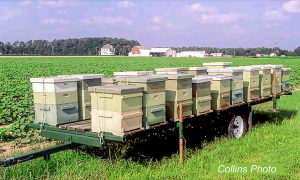
Figure 2. A commercial beekeepers’ trailered hives for pollinating cucumbers.
Jeff: The big guys, have their front-end loaders and pallets and they’re all set to do this kind of in-and-out type of beekeeping and pollination or whatever you’re doing. All the while, moving from one location to another while following the bloom, so to speak. Smaller beekeeping operations can’t afford the front-end loaders or skid loaders, and the trailer becomes a viable option. There’s a lot to consider when you’re looking at a trailer for hauling bees.
Jim: Right off the bat. You almost said it, I was waiting for it – right off the bat, “Why would I use a trailer of any size?” My immediate response is because they are generally much lower to the ground than my pickup or a larger truck. I don’t have to pick the colony up or lift the colony as high off the ground.
Yes, I can use ramps on the tailgate of the truck, but do you want someone to make pictures of you when you’re trying to pull that beehive up those ramps – backwards – into the truck? That foot and a half or so height difference really matters. If you got the right trailer, it may actually have loading ramps that are built on the back of it.
Jeff: Yes.
Jim: I find it much easier to load a trailer with bees than I do to get them up in my truck or, in the old days, on a flatbed truck, and then get them back off.
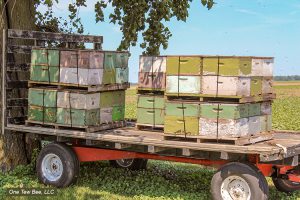
Figure 3. A hybrid-looking system using a front-end loader to set hives from the truck onto a farm wagon for distribution around the planting.
Jeff: No, it only takes once or twice of trying to load a heavy beehive into a back of a pickup truck before you realize this won’t work as a regular event. It’s good for once or twice when moving a beeyard. If you’re doing on a regular basis, the trailer really comes in handy and the lower to the ground – within limits – the better.
You have to take into consideration where your beeyards are located. If you’re doing pollination contracts or following the bloom, then you have to consider ground clearances. That becomes a whole different factor in trying to decide what trailer you want.
Jim: If you’re going to unhitch the trailer and then back it up again, yes, the beekeeper wants to know if the yard is level. Is the yard solid? In a perfect bee world, the sky is always blue, birds are always singing, and bees are always happy, but the common reality is that it’s 2:30 in the morning, the dew has fallen, the truck’s slipping on the grass, and you can’t see the hitch. You’ve got no one to help you because you’ve got no friends, Jeff. You’ve already been through all of them years ago. The devil is in the details.
Jeff: The only friends you have at that time is mosquitoes. They’re all over you.
Jim: [laughs] They’re not friends. They’re just there at the same time. I do want to put this in our discussion right now. If you haven’t done it, you are probably going to do it.
Here’s the situation. If you’ve got a smallish, single axle trailer, you listened to a podcast or you read an article somewhere, and you bought a trailer. Now it’s time to return and hitch it back to the truck. When that trailer is not hitched to the truck and the hives are not situated right over the axle, or even better, nearer the front of the trailer, the tongue will fly up in the air because you suddenly put your body weight on the back of the trailer. The axle, serving as a fulcrum, with the hives in the center, will tilt up. Suddenly, you’ve abruptly got your bees unloaded. They’ll come sliding down that trailer towards you. So, hitch the trailer to the truck first. Then work with the colonies. All those years ago, that brings me to the very next point, if possible, that the towing vehicle should be a four-wheel drive vehicle.
Jeff: Your towing vehicle?
Jim: Yes, your towing vehicle should be four-wheel drive. Like I said, the world’s not always perfect. Sometimes it’s rainy and muddy. You’ve mentioned pollination work. In fact, I’ve moved hives most of the time not for pollination work, but for management reasons.
For instance, I had a couple of hives that wouldn’t stop stinging the whole neighborhood. The move was not a huge one. This was just a move of two colonies. I’m really going to have trouble finding someone to help me move them. I still used the trailer because I’ve got bees that are stinging everyone in sight requiring me to work alone.
So, I still used the trailer – massive overkill – just removing those two genetically angry colonies to a location 40 miles away. The funny part of this story is that a bear found those two colonies. Eastern Ohio beekeepers had not had a bear-sighting in about 100 years. I almost got my name in the local newspaper. The bear destroyed those two colonies. I wrote about this in an earlier article.
Now, you’ve got a four-wheel drive truck and just a single axle trailer, maybe 12 to 14 feet long, and you’re going to take it to a beeyard. That yard must be able to take that kind of rig turning around, backing up, getting out. A lot of beeyards will not work well for trailering your bees just because you’re going to have to do some sophisticated driving and backing if the yard is too small.
Jeff: It needs to be able to handle it with a loaded trailer. A lot of times an unloaded trailer sits differently than a loaded trailer. You can get in there but you can’t get out or you get it loaded up, but you can’t get backed up. You need to put these characteristics in consideration.
When I had horses, I always used a gooseneck trailer. I love gooseneck trailers. Regarding trailers for bees, do you prefer a gooseneck trailer or a bumper hitch? Secondly, how many axles should the trailer have? One or two? Two axles is a lot more stable and you don’t have that fly-up of the hitch that you have a concern with a single axle. What’s your experience on that?
Jim: I have some guesses, some opinions, and some experience.
Jeff: Sure.
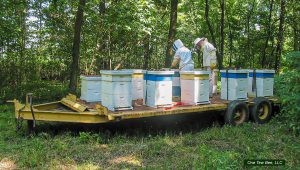
Figure 4. A heavy duty trailer with brakes and a pentel hitch on two axles.
Jim: The two-axle trailer is probably going to have brakes on it, so that really helps. Even a loaded single axle trailer, medium size, 16 feet long with 15, 20, 30 colonies of bees on it, it’s going to really push the truck. You, the driver, must realize that the stopping distance is going to be greatly increased to stop the truck. Double-axle trailers usually have brakes – surge brakes on the tongue – or something like that.
Secondly, those larger trailers are also heavier making it a different concept. More pressure on you the driver and more gas consumption. They are more stable, but there’s a limit on what weight you can put on the bumper hitch.
I pulled a trailer, loaded with good junk, all the way from South Alabama to Northeast Ohio. I didn’t notice until I was backing down my home driveway that my bumper had twisted downward on the truck making my bumper position at about a 35-degree angle. The bolts that held the bumper to the truck frame had slipped.
I was home, but I still had a fearful moment there. What if the bumper had come off? It’s a bumper hitch, so the trailer could have come loose from the truck.
Now, having gotten to this point, I have not routinely used a gooseneck. I’m going to have to depend on you. We’ve used horse trailers and made them work for moving the equipment primarily, but I never used a gooseneck trailer of any kind for moving hives. It was always a bumper hitch or a heavy-duty pentel hitch. You tell me what was involved when hooking up that gooseneck to the truck. You said it was more stable, easier to back. How difficult was it to attach a gooseneck trailer to the truck?
Jeff: It’s a much more stable ride in the wind. That trailer attached as a gooseneck is a much more secure trailer. Backing was a lot easier. It’s more natural, more intuitive, when backing. Even lining up the hitch and hooking it up was easier because, in most cases, you could see it up to the final second to the hitch the trailer in the middle of the truck bed. I understand some of the new trucks now even have a camera looking at the center of the bed of the truck. Even lining it up with a camera is just like many cars now with a backup assist. The downside is that these trailers are more expensive.
Jim: Jeff, I’ve got a question that I guess I’ll check out after we finish this conversation, but right now, can you tell me, what’s the different between a trailer and a wagon?
Jeff: When you say wagon, the only thing I can think of is it says Radio Flyer stamped on the side, or it’s being towed behind a tractor loaded full of hay.
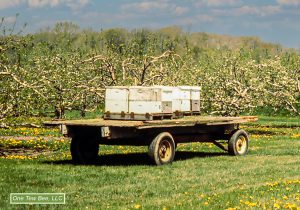
Figure 5. Pollination hives on a hay wagon. This was not a suitable trailer for the open road.
Jim: That’s exactly where I was going. Years ago, I thought I had a bright idea. I took some of the university hay wagons – they’re just very utilitarian devices – and put pollination hives on them. I nailed the pallets and the bottom boards to the deck of the trailer and then put the colony components on the nailed bottom boards. It really made a secure ride. These hives are staying on that trailer. All I had to do was keep the outer covers on.
What’s fundamentally wrong with this? Answer? By the time I got where I was going, I had a load of the angriest, most upset bees you’ve ever seen, and I realized on the trip that you can only go about 20 miles per hour. A hay wagon has no suspension system on it. It’s a slow wagon with a rough ride.
I’m hypothesizing that the difference between a trailer and a wagon is the suspension system, or the lack of it. If anybody has any interest in using a hay wagon, you’re going to have to go at 15-20 miles per hour. If you go much faster, you’re going to be bouncing bees all over the community because there’s not enough weight to settle the trailer out – even if you run the tire’s half slack. That hay wagon idea blew up on me. I was not able to use those simple farm wagons as a bee-moving device on the highway. They work fine within the orchard.
Jeff: Interesting.
Jim: When you mentioned the horse wagon a bit ago, the horse trailer, you wandered into a different arena. Those are enclosed trailers. Cargo doors close them up. I had a shock years ago using a cargo truck (not a trailer) with fold-down doors. I want to tell you it’s really easy, even when the temperature outside was in the 20’s, to overheat that load of bees in an enclosed container.
You’re bouncing them, you’re jostling them, they’re upset, they’re confined. They’ll begin to get worked up and generate heat. It was shocking to have those colonies overheat when the outside temperature was so cold. Now, as I said, that was not a trailer, but an enclosed box truck. Though it’d be the same situation with an enclosed trailer.
My situation was laughable. I had to stop at one of those all-night food stores and buy all the ice they had. While it was frigid outside, I had to put ice on those colonies to calm them down. If you use an enclosed trailer, even on a cold day, you can still overheat the colonies and suffocate them because of the jostling effect that they’re going through with all of that.
Jeff: Not to go off on this tangent but that story reminds me of the time I was in Georgia, and I did a couple of articles on Wilbanks Apiaries. I was doing an article for Bee Culture, and I was talking to the owner. He showed me around his queen-rearing facility. Of course, he does a lot of packages and he had specially designed trailers for moving packages of bees. They were temperature controlled. He can control the temperature inside that enclosed trailer for his bees, which was an interesting concept, but addresses the concern or issues that you faced.
Jim: The reason I’m on this tangent is because of the same thing. A fellow beekeeper here, who contract-hauls packages every Spring, has an environmentally controlled trailer with doors, fans, vents and thermocouples, because he basically says the load is critical. You can insure the trailer, and you can insure the truck, and carry medical insurance – but you can’t insure the live bees. If you overheat those bee packages, that’s a disaster. In his enclosed trailer he’s towing, he knows exactly what’s happening, temperature-wise, from the cab of his truck.
Jeff: That’s smart. Speaking of enclosed trailers, one of the things that I think you’ve seen, and all beekeepers have seen these days, some people and especially in Europe, they are using trailers and AZ-type hives to move bees around.
Jim: Isn’t that interesting. I’ve only seen pictures of that.
Jeff: I look at that and what I know of AZ hives, I think, boy, that would be really a great way of doing things. I still to this day like the idea of putting beehives on a trailer to make my life easier as a beekeeper, a better beekeeper, and the AZ hives could be a good way to go. Putting all of that into a trailer would be fantastic.
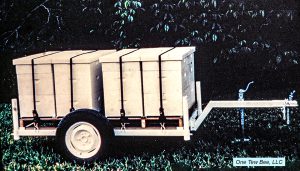
Figure 6. A custom trailer, with a detachable deck, designed to haul eight hives.
Jim: I want to go a little bit deeper down this rabbit hole that you’ve started. [laughter] About sixty years ago, a USDA researcher designed a trailer that allowed the platform bed to be jacked up and taken off the mobile trailer frame. You put four legs down on each corner of the platform, jack the platform up, and raised the platform, with the hives, off the mobile frame of the trailer. Then pull that frame out from under the platform and off you go. You took this strange looking, partial trailer-frame behind you leaving the platform and the hives at the cucumber field.
Jeff: That’s like the container trailers that we see in the Pacific Northwest all the time. I’m sure they’re everywhere. You see those without the container on them. It’s just a frame with wheels.
Jim: Yes.
Jeff: I like that idea.
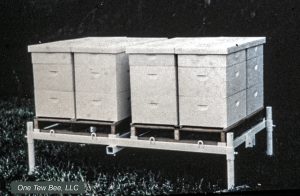
Figure 7. Platform unloaded from the trailer frame.
Jim: Let me tell you where it went. Let me tell you [laughter] why the researcher said you don’t see such bee trailers. When you’re going back to get your platform and its night and the truck’s slipping, everything must be lined up exactly straight. If the mobile frame strikes either one of those back legs, the platform dumps the colonies off the bed.
Jeff: Oh my gosh!
Jim: This very event happened and about 40 colonies either shifted or fell from the trailer deck. He had some pictures of that 40-colony load of bees on that platform, tilted to one side where he accidentally struck one of the back legs. He decided the risk was too great. The idea died.
Now there’s a Chapter Two to this saga. Years ago, I gave this same description to a beekeeping audience. To me, the audience is all beekeepers, but in reality, they’re candlestick makers, soldiers, and sometimes even airline pilots. My point is that they are a blend of people with a myriad of talents. I didn’t know I was talking to two professional welders. From my lecture description, they made that very trailer design, but on a much smaller scale. They took the rear wheel hubs from an ancient Oldsmobile Toronado. That was one of the first front-wheel drive cars.
You would lower pipe legs on the corners of the trailer bed and raise the deck off the frame. There’s ways to do that, but I won’t go into it. Then, with the deck picked up, the wheels are off the ground. You pull out a pin, pull the wheel hubs off, put those in the back of the truck. The tongue was also detachable. You put that in the truck, too. Then in theory, you took the two wheels and the tongue back to the home apiary where you had what? Other platforms. Then you hauled eight different colonies somewhere else. This design was for a small bee operation. That’s why I told you a bit ago that I thought the difference between a trailer and a wagon was suspension.
The idea didn’t go anywhere. Not because you knocked out the back legs, but because the ride was so rough that we’re now back to 15 miles an hour again without a suspension system on the trailer. You just about can’t use it to move bees because it’s so rough on the colonies. This idea, this beautiful, professionally made piece of equipment – one of a kind – never developed. It was just another idea for people exploring what beekeepers could do with trailers to keep from having to unload and reload bee hives.
Jeff: Considering the amount of brain power that’s been put into that over the years by various beekeepers, I’m surprised there’s no easy, readily made solution these days.
Jim: I want to finish on this note. If you have a big truck towing a large trailer and you’re on a narrow country road getting to a beeyard, you better be crystal clear that that truck will make the turn through the gate that you’ve got to go through to get to where you’re going to drop those hives. Because one night, long ago, there was no way – the geometry was all wrong – that I could get my big truck to turn with that long trailer behind it to get through a narrow farmgate.
We had to unhitch the trailer in the road, unload the truck in the out-yard, bring the empty truck back, take the hives off the trailer, load them on the truck, then take the truck to the drop-off site and unload it again. A lot of good it did to have a trailer behind the truck that night. [laughter]
I love trailers. If you don’t have a trailer behind you when you’re moving bees, you’re just not doing your job correctly. Of course, I am kidding. There are quirks to trailering. All trailers have them.
Jeff: I think it comes down to understanding your use of that trailer and your beeyards. Not only can you use that trailer in your beeyard or your multiple beeyards in nice sunny weather, but can you use that trailer in that beeyard on the worst possible days in the dark?
Jim: And do it all by yourself?
Jeff: Yes, by yourself. It’s just that not every yard is on a flat surface. It’s not always going to be on a flat asphalt surface. It’s going to be on an angle, it’s going to be wet, it’s going to be in the mud and the bees are not going to be happy. We haven’t even talked about how do you secure the beehives to the trailer?
Jim: That is a totally different subject. Ratchet straps, hammers, staples. Do not think that the propolis seal will hold that equipment together. Don’t think that the colony will stay together because it’s stuck together with propolis. I have tried that. You’ve got to strap them, but now we’re off the subject. I like trailers, I want to use them for everything. If you use them, they’re going to come with some quirks and caveats, but overall, they give you a broader aspect of beekeeping.
Jeff, I enjoyed chatting with you. Thanks for educating me.
 Dr. James E. Tew
Dr. James E. Tew
Emeritus Faculty, Entomology
The Ohio State University
[email protected]
Co-Host, Honey Bee
Obscura Podcast
www.honeybeeobscura.com
Click Here if you listened. We’re trying to gauge interest so only one question is required; however, there is a spot for feedback!
Read along below!
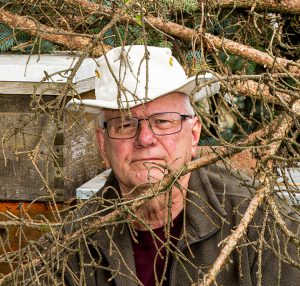 The Stark Reality of Being a Long-Term Beekeeper
The Stark Reality of Being a Long-Term Beekeeper
By: James E. Tew
Overall, beekeeping is enjoyable – but it’s not always easy
Readers, in several previous articles, I have danced to this tune with you. Yet, for personal reasons, I feel a need to try again. Though many of us feel it, it’s not easy to explain what we feel about our bee efforts. I am an entomologist and I do not have a deep background in human psychological issues. Clearly, I should stick with what I know, but sometimes I just need to write about what I feel. Even so, I struggle to word it for you. My core thought is – Though beekeeping is generally rewarding (After consideration, I have opted to use the word “rewarding” rather than the word “enjoyable.” Cleaning dead-outs is not enjoyable, but as I prepare the fouled equipment for future use, I feel rewarded.), it’s not always easy.
I’ve done this bee thing for a long time
Having a long history in keeping bees is a helpful attribute for any beekeeper. You remember “when” and you acquire a lot of personal bee-related stories. You learn a lot.
Through the years, I have learned that my bee interests will cool a bit during Winter months. So, I adapt to that reality. During those cold, quiet periods, I read about bees, or I write perfunctory articles about understanding more about our craft. I assemble or repair equipment. I plan for the next season. I just try to stay busy in my craft during this down time. While it is a useful time, this quiet period cannot be called true beekeeping. Rather, those times are “preparing for actual beekeeping.” Try as I might, my bee interest drops to a lower ebb during these slack periods. How could it not?
From experience acquired during many previous quiet Winters, I know this bee-related seasonal feeling is coming. I expect it. It’s a normal part of my beekeeping psyche. I also know that when Spring comes around, I will – just like my bees – once again awaken and heat back to a higher level of beekeeping interest. In my earlier years, I don’t recall a mentor telling me that my bee interest would naturally rise and fall – usually based on the passing of annual seasons.
Building a fire
Successful beekeeping is much like building a glowing bonfire. Fuel must be accumulated. Dates are set. A location is selected. All is made ready. The fire is ignited, it starts slowly and, as more fuel is added, it steadily grows until it reaches its capacity. Then, invariably, it begins to ebb. Without more fuel and tending, it will die out and extinguish. Interest in beekeeping is much like building a fire. It waxes and wanes. Unfortunately, for some of us, the fire goes out. The good news is that the fire can be rebuilt.
In the May 2023 issue of this magazine, I broached some of the feelings that I have about beeyards that I have now vacated. That was one of my most recent efforts to write about beekeeping feelings.
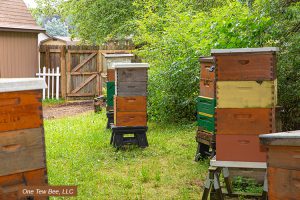
Figure 1. Part of my beeyard in better times.
In that piece, I described the upcoming fate of my oldest yard – my home yard – and how I will need to adapt to having new, near neighbors and a new street abutting my beeyard. I covered my feelings about that issue in my writings for that month. All things change, don’t they?
Then came the wind storm
In early April 2023, a significant wind storm, lasting three days, blew through my area. Trees and apiary damage was all about me. My bee equipment was scattered helter-skelter. On two consecutive stormy days, I had a fifty-five-year-old Colorado Spruce come down. These trees abounded my apiary.
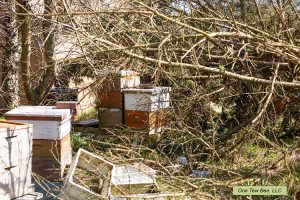
Figure 2. It is not easy working these hives.
On one hand, I can’t complain too much. One tree fell away from my beeyard while the other precisely fell in the only place it could to cause the least damage. I still had three colonies that were crushed. The high wind apparently blew the bees away. There were only a few remaining bees in those obliterated colonies. They did not survive. However, the damage could have been worse. On one hand, that’s the good news. On the other hand, I now have a huge tree down in the middle of my home yard and I have bee equipment either destroyed or scattered throughout my yard. (You must know that I will not be giving any tours of my beeyard any time soon.)
What a mess
I confess that I feel overwhelmed at the prospect of clearing this chaos. I suppose I will select equipment that is still usable, or can be made usable, and form a burn pile for the remainder. But it gets even better. In the middle of all this confusion, I must move the living colonies from the area. Here’s why.
The tree removal people
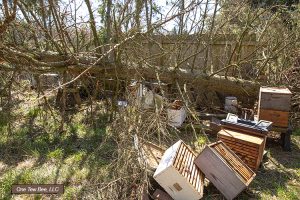
Figure 3. Part of my beeyard challenge.
I had tree removal people come to view the situation. Being professional arborists, I had hoped they would be reasonably comfortable around flying, confused bees. That did not happen! As the tree company representative reviewed the scene – and the bees – from the blue, he asked, “If the bees are a problem, do you mind if we spray them?” Readers, I was truly astounded. I think that I probably gasped. Again, I must write that I was stunned. Within that scenario, I would have even more dead bees and a new category of mess. Now I would also have pesticide contaminated equipment to deal with. After a few seconds, I was able to form sentences and was able to tell this uninformed guy that, “No, I will move these hives to a distant location so his workers could go about their business of tree removal.”
Much like the old late night TV commercials, I now tell you, “But wait, there’s more!” Probably sensing that he had just mightily offended me, he tried to rebound by showing feigned interest in bees. He asked, “There’s a queen in that box and the bees surround her – right?” I felt as though I was having some kind of medical exam. I just wanted this whole encounter to be over. I responded that he was somewhat correct but having NO interest in trying to teach beekeeping, I immediately returned the problem of the downed trees. He gave me a fair price and left to attend to my neighbor’s downed trees.
This was all a new and unfamiliar reality, being a long-term beekeeper. I have never had my apiary so discombobulated. Then in addition, having people so unfamiliar with bees be so intimately associated with my colonies and with my stressed psyche was a new learning experience for this old beekeeper.
I’m still learning
As I have worked to clean and reorganize my apiary site, I have clearly learned that having a large coniferous tree in the very middle of your apiary is not a positive beeyard feature. As a younger man, I would have fired up my chain saw and removed some of the barrier to my bees. I’m not a young man and I am paying a professional company to clear the mess. Let them earn their money has been my feeling. So, I have been trying to work around the big tree as I gather equipment and rearrange bee hives.
I wear high-quality ventilated bee suits. As if to make bad things worse, the needles on the dead tree grab my bee suit and puncture me. At first it was surprising, then it was frustrating, but the stabbing and sticking progressed to being outright annoying. I can hardly move in my apiary without my suit being grabbed by prickly needles that are strong and determined.
But wait, there’s even more!
You recall that I have other issues beyond the downed trees. Remember that I will be having new neighbors located near my beeyard. With this reality in mind, last Spring, I had what I originally thought was a genius idea. I will allow Multiflora Rose, an invasive plant, grow to form an impenetrable barrier between me and my new neighbors. After all, that was the original intent of introducing this obnoxious plant into this country. It was to be a hedgerow plant. Unfortunately, the plant went derelict and is now nearly uncontrollable.

Figure 4. Multiflora Rose in full bloom. Photo credit: Leslie J. Mehroff, University of Connecticut
Multiflora Rose and ventilated bee suits
Being otherwise cut back, this mega-prickly plant now grows at the edges of my beeyard, but in the storm, confusion and destruction, the unwelcome plant has also been upset. Its tentacles reach here and there and, in some cases, snakes through the branches of the downed tree. As bad as it is to have pine needles grabbing my bee suit, Multiflora Rose is profoundly worse.
It is as though the plant is alive. In snake-like fashion, it grabs my suit and dearly holds onto me. I literally rip it off only to have it whip back and grab me again. On two occasions, I had to remove my suit to get the vine detached from my suit. I must wear bee gloves to deal with the thorny plant, not for protection from bees. I can only candidly write that this is not an enjoyable episode in my beekeeping journey.
The stark reality of being a long-term beekeeper
This month, I will be seventy-five years old and I will have been keeping bees for fifty consecutive years. Yet, I am essentially starting over again in my home yard. I’m either impressively dedicated or a very slow learner.
As traumatizing as it has been for me, I have begun to accept the reality that my most personal beeyard was going to change anyway. I was preparing to deal with that reality. Now, part of my tree barrier has vanished. Even more changes are coming.
While trying to make lemonade from lemons within this fallen tree situation, I admit that, in a bizarre way, the trees coming down will assist in additional future fencing that I would be needing anyway. I have already been forced to relocate the remaining colonies to another temporary location. I was going to need to do that task later this Summer anyway.
For the first time in more than forty-five years, I will (temporarily) not have any hives at this location. The yard will essentially be wide open. No trees, no bees and heavy construction nearby. I have a rare window to completely restructure my core yard into a “new and improved” location. I plan to electrify my little bee storage barn and install cameras for security and observational purposes. So, is this a disaster or an opportunity?
Yet another reality of beekeeping
Several of my local beekeeping friends have offered to help, but so far, I have politely declined their offer. Why? Because of “feelings.” These are my bees and they are my responsibility. If I can’t do the job, then I shouldn’t take on the job. For reasons beyond my comprehension, I’m on a lifelong apicultural journey and it’s my thing. I should not seek help from others for the occasional distasteful aspects of my journey in order for me to be able to enjoy the positive aspects of my journey. No doubt, I will get back to you if any of this situation changes in even more unexpected ways.
My lifelong good friend once said…
I once had a lifelong professional friend tell me that I only wrote “disaster” articles. It was a passing comment that he made in jest that I have never forgotten. In fact, I do write about stressful beekeeping events because, to me, those are the events, the episodes, that make me grow in my chosen craft. These trying episodes give me unwanted depth and forced understanding. Also, my trying experiences make me compassionate when other beekeepers tell me of their issues and concerns. Therefore, in this article, I choose to use the word, reality rather than disaster.
I will clean this situation up and I will reestablish colonies in my home yard. It will take a lot of work that is not particularly enjoyable and it will require me to take a lot of naps. It’s beekeeping. Overall, I enjoy parts of it immensely.
 Dr. James E. Tew
Dr. James E. Tew
Emeritus Faculty, Entomology
The Ohio State University
[email protected]
Co-Host, Honey Bee
Obscura Podcast
www.honeybeeobscura.com
Click Here if you listened. We’re trying to gauge interest so only one question is required; however, there is a spot for feedback!
Read along below!
 Honey Bee Cannibalism
Honey Bee Cannibalism
And some other quirks of our beloved bees
By: James E. Tew
I don’t know how to start this conversation
A question came to me that found me unprepared and uneducated on the queried subject. This is not an uncommon situation for me. I have an abundance of bee questions for which I have no answer, but my interest in this question lingered far beyond its derived answer.
Becca F., a beekeeper friend from north Florida, phoned to ask me, “Why are some of the bees in one of my colonies eating some of its brood?” The colony in question was from a cut-out (A “cut-out” is a colony that originated when a beekeeper relocated it from a natural nest site, such as a hollow tree or the wall of a house, to standard hive equipment.) from late last season. Other than some destroyed brood, all other biological characteristics of the colony seemed in good order. You should know that, at the time of the phone call, the 2023 Spring season was well underway in Becca’s area.
From nearly nine-hundred miles away, I really could not say what was causing this disappointing behavior in her distant colony, but I felt that we could, at least, narrow the possible reasons. Narrowing the issue is not the same as answering the issue. If there is a food shortage (probably protein) or if a perceived pathogen is present, I surmised that nurse bees sometimes eat larval brood. I proffered a guess that if all other brood stages seemed healthy, and copious food stores were present, and a pollen and nectar flow was still yet to come, this mysterious issue would most likely resolve itself.
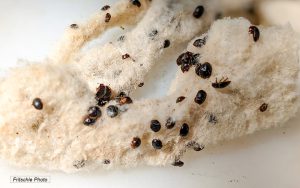
Figure 1. Small Hive Beetles, the cause of brood destruction.
Indeed, it did. Apparently, a Small Hive Beetle (SHB) population had grown within the colony to the extent that some of the bee brood was damaged. Selected bees were striving to regain control of the situation and were eliminating damaged or dead brood. Providing some beetle traps and some microfiber cloths seemed to help the bees regain control in the afflicted colony.
From afar, I was able to do nothing that was helpful. The beekeeper and the bees had seemingly won this battle, but the situation lingered in my thoughts. That some of the bees from one of Becca’s colonies was actually killing and eating some of its brood was a curiosity that stayed with me. Such cannibalism is documented colony behavior in the beekeeping literature. You and I both know that fact, but exactly how does it work? When and why does it work?
Through the decades
Through the passing decades, many times I have alluded to the fact that bees will, at times, “eat” some of their young. With superficial confidence, I have told audiences that these cannibalistic bees are selecting older larvae first. Why? Older larvae are the colony’s major food consumers. Younger larvae seemingly would be on the short list and would be consumed as the older larvae were eliminated. Honey bee eggs will have not yet become food consumers and developing pupae have already completed the eating stage. They are reasonably safe. However, larval stages would be in serious trouble if food stores were stressed.
For hygienic reasons, bees will also remove diseased brood from the colony. At this point, I have few answers, but many questions. Will nurse bees intentionally consume the larval contents as they dispose of their diseased brood? If so, are they re-purposing the larvae’s fluid contents as food or are they removing the contents to expedite getting the dead brood member to the colony entrance? Or both? I have more comments on this concept later in this piece.
Mature honey bees
Let’s just get this out of the way. I cannot recall of an instance where it was documented that an adult bee consumed another adult honey bee. Maybe – and completely hypothetically – I suppose that under specific undocumented situations, if a nectar-ladened worker was killed (i.e., crushed, mashed or just died) and the contents of her honey crop was somehow available, that sweetness could be of interest to other living house bees.
Yes, that scenario is a wildcard, but a scenario like that one is the only incident in which I can envision an adult bee having an interest in cannibalistically eating some of the contents of another adult bee. So again, adult honey bees do not see other adult bees as a food supply.
Maybe for another time, and on a different subject, birds, toads, spiders and other insects certainly do view adult honey bees as food sources. Adult honey bees are readily eaten by these animal species.
Laying workers
When lauding the productivity of a beautiful queen, I have sometimes stated to audiences that, “Nurse bees will police any defective or incorrectly placed brood by eating/removing it.” In effect, this has the effect of making the queen’s output look very good because the workers corrected her mistakes. Well, in a way, she is good at her genetic job, because her offspring had that innate ability. But what about defective queens or even laying workers?
Though I feel a bit shaken, I still support the concept that healthy workers will eat/remove laying worker eggs when they find one. Just exactly how the worker perceives the defective egg is far beyond my knowledge. But I again write that I have lost some of my nerve. Are the workers eating the haploid egg or only removing it? I have been told, and I have re-stated to others, that viable workers truly eat the defective egg.
Indeed, I have read, and subsequently repeated to others, that to a greater or lesser extent, laying worker eggs are commonly found even in healthy colonies – especially when the brood and adult population are high and healthy queen pheromone levels are stretched across the large population. During those times, viable adult workers are constantly removing these sly, worker-laid eggs. Then again, I would boldly say to an audience, “They eat them.”
Whereas, I was once confident in this statement, I have recently grown more reticent. In my fifty plus years of beekeeping, I have never seen an egg anywhere but in a cell. Are these undesirable eggs really being eaten or did I simply not notice a tiny, white egg laying outside on the landing board as it was being discarded? I don’t know. Maybe I just missed it. I will try to be more observant.
Immature queens and drones
I feel that you and I could agree that immature queens and drones are “eliminated” when they are no longer needed. Queen cells are frequently torn down and contents removed if such cells are unneeded.
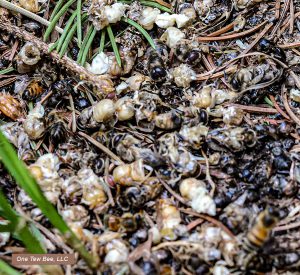
Figure 2. Dismembered drones at the colony entrance.
As have you, I have seen partially dismembered drones that were being removed from cells. Were they dismembered to ease the removal process or were juices and cellular fluids consumed? I don’t know. I offer this thought at this point; I dangerously assume that liquid contents would be eaten – if for no other reason that nest cleanliness.
Hygienic behavior
Where would honey bees be without this cleanliness behavior? Queen breeders select for this attribute. Scientific careers have been built on this concept. We wish all our queen stocks exhibited this characteristic. But there are instances when the process turns negative for both the bees and their keepers.
For instance, while removing infected brood, nurse bees’ brood food glands may become contaminated with bacterial spores of American foulbrood (AFB). Those nurse bee carriers then feed susceptible young larvae along with pathogenic bacterial spores that perpetuates AFB within the colony’s young brood population. In many presentations, I considered it humorous to tell audiences that nurse bees did not have small stainless-steel buckets and cleaning cloths. Therefore, the only way they could remove the diseased larval debris was to eat it. In retrospect, this may not have been as funny as I thought.
There is abundant published literature (2Posada-Florez, F., Lamas, Z.S., Hawthorne, D.J. et al. Pupal cannibalism by worker honey bees contributes to the spread of deformed wing virus. Sci Rep 11, 8989 (2021). https://rdcu.be/c8o25) that explains how hygienic cleaning spreads deformed wing virus. At this point, I am left with nothing to write. If the colony does not keep itself immaculate, the viral disease spreads. If it cleans itself and keeps colony conditions immaculate, the viral disease spreads. This is a true conundrum.
This spread occurs because bees are in direct contact with virus particles as they clean/eat the diseased brood. I sense that the best solution is to prevent varroa-vectored viruses from gaining a hold in the colony; therefore, the alert beekeeper should constantly suppress varroa populations. At this point, I am forced to admit that if I don’t manage varroa first, I will have much greater problems managing my bees later. This too, is a topic for another time.
Seasonal adjustments
It’s harsh. As humans, we are nearly unable to tolerate the concept, but to bees, brood is potentially food in a form other than bee bread or honey. At this moment, as I write for you, my Spring season is just beginning. Maple is in bloom as are other early season food sources. So, of course, the weather swings between being nice and warm to absolutely wintry.
If my bees have been on time, there is a significant brood population being developed within my colonies. Suddenly, due to cold weather returning, there is no pollen coming in. Not only must the brood be fed, but it be kept warm. What should nurse bees do? It seems that they heartlessly cut their losses. If they perceive that protein is in critically short supply, they stop feeding the oldest larvae, consume them to re-purpose their body fluids to power their nurse bee brood-food glands, and await the restart of the seasonal pollen flow. Such seasonal fluctuations occur everywhere, not just cold climates.
During serious dearths, using brood as food is a brutal but logical thing to do. Could it then be written that bees’ diet is honey, pollen and in trying times, its own bee brood? Yes, this seems harsh to human beekeepers.
Honey bees eating process
Through the years, I have spent significant time trying to understand the “chewing-lapping” mouthparts system that bees use to consume their food. While I think I understand the basics, I readily admit that I do not grasp the finer details of this complicated process. Lacking typical chewing jaws and essentially only consuming a liquid diet, how do bees actually eat a larva? Indeed, how does a bee eat pollen or anything else solid?
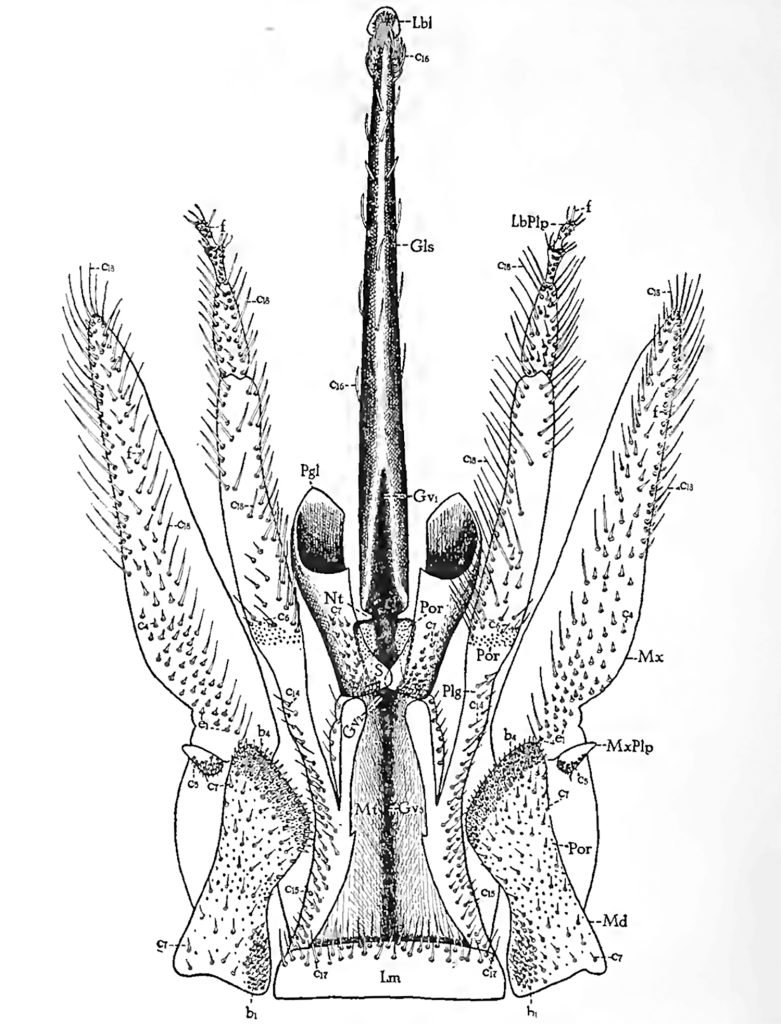
Figure 3. The complex honey bee mouthparts (Snodgrass)
While searching a plethora of complex literature on honey bee mouthparts, I stumbled across a very old pamphlet from the Smithsonian Miscellaneous Collections by N.E. McIndoo (3McIndoo, N.E. 1906. The sense organs on the mouthparts of the Honey Bee. Smithsonian Miscellaneous Collection, Vol 65, No. 14. https://repository.si.edu/bitstream/handle/10088/23540/SMC_65_McIndoo_1916_14_1-55.pdf?sequence=1&isAllowed=y). This author reported that bees, using enzymatically reducing saliva, convert some solids to liquid forms thereby allowing the bees to “drink” the heretofore solids. Alternatively, if the solids are small enough, other supporting mouthparts, “in crane-like fashion” lift the small particles to the bee’s mouth where they are subsequently swallowed. For the hyper-interested reader, in clearer description, this bit of information was deeply buried in the fifty-five-page document and can be found on pages 39-41.
An aside…
Through the years, I have admonished honey bee enthusiasts to understand and respect all insect and animal life – not just honey bees. All species have some astonishing characteristics and abilities that seemingly make them stand above their other animal peers. Ergo, honey bees are amazing, but so are many other animal species. But I want to get sappy for a bit. The function and complexity of honey bee mouth parts astound me. Admittedly, I am not a honey bee anatomist, so I struggle to understand this complex system that honey bees whimsically use. I suggest that these hidden mouth parts and their functions are every bit as elegant as the dance language behavior and orienting capabilities of honey bees. In my opinion, bees’ mouthparts deserve more respect than they have gotten.
So, are honey bees vegetarian?
Under dire conditions, some bees will eat some of the colony’s developing brood. Can we agree on that point? If that is true, then can it be stated that honey bees are vegetarians? Maybe not. In fact, things are even more complicated. When bees gather and store pollen, they also collect microbes that live on and in pollen4. Those microscopic animals are also eaten by bees. Some researchers feel that this “meat” is an important overlooked food nutrient for honey bees. As you would expect, this is causing some consternation within scientific circles, but the concept seems to have a toehold at this time. So, are honey bees truly vegetarian? Maybe not.
Just one more thing – robbing behavior
I am out of space, but just one more thing. If robbing bees are maniacal for any food from anywhere, why do they not murder all the larvae in the colony being robbed and imbibe their body fluids? Do they? Honestly, I have never looked. Those large larvae are certainly a potential food source in the weakened colony.
As you know, a robbing episode is NOT the best time to pull all brood frames out of the robbed colony to have a look at whether larvae have been killed, but maybe I should have a look just one time. Please let me know if you see something in your robbed colonies.
Thank you.
To Becca and her bees, I offer a thank you for spurring me to think. To the readers who struggled through this piece, I thank you for your time and dedication to our bees.

Dr. James E. Tew
Emeritus Faculty, Entomology
The Ohio State University
[email protected]
Co-Host, Honey Bee
Obscura Podcast
www.honeybeeobscura.com
Click Here if you listened. We’re trying to gauge interest so only one question is required; however, there is a spot for feedback!
Read along below!
 Beeyards Come and Beeyards Go
Beeyards Come and Beeyards Go
An apiary location is just for the moment
By: James E. Tew
An unusual topic
A strange topic this article has – Beeyards that I no longer have. Old, abandoned beeyards have played a major part in my personal beekeeping history and development. They are like long departed friends. Many of you have your old beeyard memories, too. I’m not special in this regard.
As the years have passed, I have steadily cut both the number of hives I manage and the number of yards I keep my bees in. Throughout my career, I estimate that I have had – at one time or another – about 45-60 permanent bee locations. At my peak, I (with help) maintained about sixteen different locations. Now, I have reduced my yards to only two apiaries, both reasonably near me. Yep, that’s quite a change for me.
My emotional attachment to some of these phased-out yards has surprised me. They have names that are totally meaningless to you, but they have been part of my life for years; the Metz yard, the Shreve yard, the Chipley yard, the County Home yard, Matt’s yard and the Fredericksburg yard are some of the many names of places that have now reverted to non-bee areas.
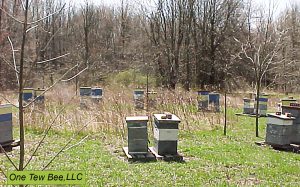
Figure 1. The Metz yard, twenty-five years ago
Specifically, the Metz yard and the Fredericksburg yard were locations that I personally established as a brand-new entomology professor at OSU in 1978. It seems impossible that I had some of these locations for 40+ consecutive years only to close them out. As a young man, I guess I just assumed that these yards would somehow continue forever.
In the case of the Metz yard, it was located off Metz Road, right here in Wooster, Ohio. At that location, through the years, I survived stuck trucks, swarms, American foulbrood, tall grass, the introduction of mites and ground hogs, but on the positive side we made a lot of honey there. Being located near a stand of pines, I, and my help, would gather bags of pine needles for our smoker fuel needs. At the time, it was a major part of my beekeeping psyche.
We were there so long that many years ago, the Senior Mr. Metz died requiring us to get permission from Mr. Metz’s surviving son to continue the use of the yard. He allowed us to stay so I passed into my second generation at this location. Then after decades of use, I finally gave it up, too.
Where is this reminiscing going?
Eliminating these yards made me realize that I have evacuated far, far more yards than I will ever again maintain. Yet each of those now abandoned locations was, for a while, a part of my beekeeping life. Stories and bee events came and went. Now nothing of a bee nature remains at these locations. In fact, there are only a very few people who could even remember the hives were ever there. That’s okay. It’s only important to me anyway.
Memories of some of my long-gone yards
Not all the memories that follow are specifically my yards, but they all contribute to my beekeeping memories. Here are some examples.
The Unit-Two Yard
The reason for the clumsy yard name is unimportant, but the now long-beeless yard has several significant memories for me. It was in this yard that I had the very personal experience of having a mouse run up inside my pant leg as I was removing supers from a hive. I have relived the story literally hundreds of times at meetings across the country, and I choose not to relive it again here, but you can believe that I will NEVER forget the experience I had in that yard (and neither will the mouse).
Reason for giving up the Unit-Two yard. Pesticides. The yard was located near university field plots and every year, the hives located there were seriously damaged by pesticide kills. I now wonder, in light of decreased pesticide use, if that yard could be reoccupied.
The Eck Yard
Mr. Clarence Eck was the grand old beekeeper in Wooster for many years. He was keeping bees long before I moved here. Mr. Eck is no longer with us, but he and others, including Jim Thompson, a frequent contributor to Bee Culture and longtime beekeeping friend, initiated a small beekeeping workshop for helping new beekeepers. This past March, the 44th annual version of this workshop, with hundreds of people in attendance, was conducted. Mr. Eck’s home beeyard, and one in which he conducted early beekeeping classes, was north of Wooster. That yard, too, is now gone.
Reasons for Mr. Eck giving up this apiary site. Concerns from the local Ford Motor Company dealership was the reason for abandoning the yard. The newly located dealership could not figure out where all the “birds” were coming from that defecated on their fine, new cars. It took them a while to figure out that it was neighboring bees – not birds – causing the issue, but when they did discover that it was bee poop on all their cars, under threat of lawsuit, a historical bee location was forced into oblivion.
The Sawmill Yard
In fact, the sawmill and the beeyard are now both gone. About thirty-eight years ago, I wrote a series of articles for the old Gleanings in Bee Culture under the mast head, The Solitary Beekeeper, from experiences I had in this yard. It was from this apiary, that I took a good friend to the hospital emergency room after he had a systemic reaction to multiple bee stings. His tongue was swollen and had become bluish. He recovered in good order, but he won’t ever forget this bee place. Neither will I.
This yard was located on the property of a large, creepy, abandoned state mental hospital. While moving beehives past midnight one dark, quiet night, I inexplicably became spooked – one of those sixth sense things. I couldn’t talk myself out of the threatening feeling. I unhooked the bee trailer from the truck and left some of the hives open and in disarray. When I returned the next day – nothing. No Big Foot – no monsters – no nothing. I recently did a podcast describing this recollection. Now, nothing remains there but memories.
Reasons for giving up the Sawmill Yard. American foulbrood outbreaks and agricultural encroachment. The yard is now a soybean field and the sawmill building is standing derelict.
The Chipley Yard
During the early ‘80s, I kept a yard of about 80 hives of Ohio State (OSU) hives in Chipley, Florida. At the time, I had a thriving international beekeeping program made up of people who wanted to learn more about migratory beekeeping. I wintered OSU bees in Florida and produced Springtime queens there.
I have many, many memories of driving trucks to Florida, loaded with palletized beehives, dead tired, stressed, but being a real migratory beekeeper. It was a spectacular amount of work. No one got hurt. We kept good bees and we all had a good experience. To this day, this yard makes up the bulk of my migratory beekeeping experience. I have a life-long collection of memories of “stuck trucks and late nights” from this yard. As usual, I wrote about my experiences.
Reasons for giving up the Chipley Yard. Bee program redirection, transportation costs and mud (accessibility). I understand that watermelons are now planted where our beeyard was once located.
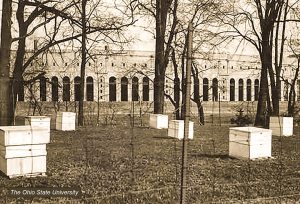
Figure 2. The Ohio State University football stadium, circa 1940s. There are no bees there today. This photo shows how much society has changed.
Multiple Ohio State University Beeyards
I don’t even know how to review all the Ohio State University honey bee program yards that have come and gone. One of the most famous was beside the football stadium. If I put bees that near the stadium today, people would freak but in the 1940’s, it was fine.
The first beeyard here in Wooster at the OSU Research Center where I worked is now a parking lot that I frequently drive past. While looking at several hundred cars in that parking lot, who would ever believe that it was once a grassy beeyard?
Reasons for giving up these various Ohio State yards. Civilization encroachment in nearly every case.
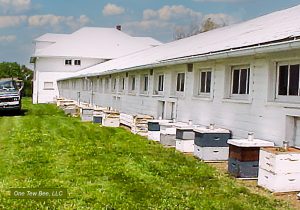
Figure 3. The Bee Barn and Beeyard in 2002.
The Bee Barn
In an earlier life, the Bee Barn was a university swine facility, and then a turkey facility. Then in its later life, and after a thorough steam cleaning, it became the Bee Barn. It had everything – even a restroom and was partially heated. It was absolutely filled with eighty years of beekeeping equipment and supplies. In 2010, a tornado utterly destroyed it – completely. Today, nothing remains of the bee barn, the beeyard or any of the equipment that it stored. It’s an open, grassy field. Nothing but memories remain.

Figure 4. The Bee Barn and Yard after the 2010 tornado. Today, nothing remains but an open field.
Reason for abandoning the yard was complete destruction of the facility and the hives.
My oldest remaining yard
I have kept bees at the back of my home property for forty consecutive years. One of the primary reasons that I moved north of town was to be able to keep bees on my property. From that apiary, I have produced multiple videos, written tens and tens of articles, made several thousand photos and produced podcasts. I have sat in that yard, watching my bees, for thousands of hours. It was my haven during the covid pandemic. It was my private, quiet place.
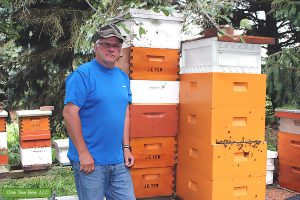
Figure 5. Jim Tew, with some of his bees in his home yard that will have to be relocated.
Now, as I have written before, within twenty feet of my colonies, a new housing subdivision with multiple housing units is being built this Summer. Heretofore, the area behind me was a soybean field. The access road to the division will be hardly ten feet from my some of my current bee hives. It does not matter that I was here long before the housing project. I will surely get complaints from construction people and subsequent home owners.

Figure 6. C. Eck and Jim Tew forty years ago (1982)
Do you recall Mr. Eck, the Wooster beekeeper, who I wrote about earlier in this piece? He had a beeyard behind his house, too – just like me but even closer to his home. The City of Wooster built a grade school on the property that joined the rear of his house.
For years, Mr. Eck, the bees and the school kids lived together agreeably. Only a wire fence separated them. Quite a while ago, Mr. Eck passed and his bees were sold. Then, recently, the school was permanently closed. A Caribou Coffee Shop stands on the location now. In this case, everything is gone – the beekeeper, the bees, even the school, but for many years, that was a hive hot-spot. I cherish the memories.
But times have changed. Now, I don’t think I can have bees so near new homes that could possibly have children – especially curious ones who go exploring. So, yes… I am making plans to move my colonies until the construction phase passes. Apparently, in my life, no beeyard location is sacred.
But again, times have changed. I am now much older. In the past, I kept 20+ colonies in my back yard – far more than I should have. But I lucked out and nothing ever happened. I no longer want nearly that many colonies there. Maybe… just maybe, I can put two to three colonies there again. I have some fencing up already and I will install even more.
So, the beekeeping humor here is that, due to aging, and passing time, I have reduced my apiary locations to only two sites. Of the remaining two locations that I now have, one is having a housing property built nearby and the other is apparently home to a roving bear that destroyed one of my colonies this past year. Readers, presently, I have zero good locations. Beeyards are weird like that. Good for a while and then not good.
Here’s the truth
If you have hung on to this point, you must have figured out that I am writing this piece for me as much as for you. I must have several hundred slides, digital photos and videos of various beekeeping events in yards that are now beeless. Most of these pictures recall good memories of bee times past.
Though not the only reason, but a primary reason for me evacuating most of the yards that I have deserted was some kind of encroachment—not just urbanization. In some instances, farmers wanted their land to put back into cultivation. For example, watermelons in Chipley and soybeans in Ohio. The Ford dealer causing Mr. Eck’s yard to be move is an instance of commercial encroachment. I am now experiencing housing encroachment.
Secondly, a common reason for giving up yards was accessibility – mainly mud and narrow gates – that would trap my bee trucks. Here’s the oddity. I have never once left a yard because of a lack of bee food sources or limited water supply or a damaging frost pocket or because my hives couldn’t be faced to the east or some such. I left all these locations because of encroachment, mud and in a single case – pesticides. It doesn’t help that I am aging. I gave up some locations for that reason. When I pass by these abandoned apiary sites, I usually have a look and think, “I used to have bees there.”
A beeyard is a bit like the circus coming to town. Lots of planning, preparation, activity and work, only then to be gone. All that remains is memories of the circus. Some yards last much longer than others, but sooner or later all beeyards give it up only to become memories for unique people like you and me.
You just wait
If you keep bees long enough, you will get your own “abandoned yard” memories, too. But shake them off. No doubt, right now you should be out in your present yard doing bee stuff. Let the future take care of itself. Thank you for reading.
Dr. James E. Tew
Emeritus Faculty, Entomology
The Ohio State University
[email protected]
Co-Host, Honey Bee
Obscura Podcast
www.honeybeeobscura.com
Click Here if you listened. We’re trying to gauge interest so only one question is required; however, there is a spot for feedback!
Read along below!
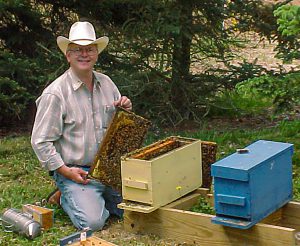
James E. Tew with two splits (Circa 1995)
Buying and Establishing Bee Colony Splits
Lots of suggestions, but not many rules
By: James E. Tew
No doubt, you’ve heard this before
When either presenting or listening to a discussion on increasing bee colony numbers, there is always an informational requirement to list the four major ways to increase colony numbers: (1) Buy a package of bees, (2) Buy a colony split, (3) Capture a swarm or (4) Purchase a fully functional colony from another beekeeper (Removing bees from a building or a tree is an unlisted specialized method of acquiring bees. For most of us, such events do not routinely occur).
Nearly always, the presenter then elucidates the advantages and disadvantages of each option. Procuring a swarm requires good luck and purchasing a colony requires just about as much luck, but much requires more monetary investment. The two surest options for increasing (or replacing) colony numbers are buying a package or buying a split.
Package bees
Purchasing a package of bees is the tried-and-true option for getting new bees at a time when you are most prepared for them. While I have always enjoyed installing packages, some common problems can present. Maybe something goes wrong with the queen. Maybe the bees drift to other colonies. But I suspect the most routine negative characteristic of package installation is the adult bee population drop that begins to occur within a few days after the package is installed. This happens every time and in every package.
In total, it takes a serious amount of time for the queen to become established, begin laying, brood to develop and then twenty-one days later, for new workers to emerge – maybe four to five weeks. Therefore, four to five weeks after the installation date, the beekeeper has significantly fewer bees in the hive than when the package was originally installed. Any worker bee that died during that broodless period was not replaced.
Colony splits
Colony splits with established queens on a brood nest eliminate the characteristic population decline that is experienced with package bees. Those are the main selling points for colony splits. The split comes with an introduced queen that should be laying the entire time that the colony is being established in your yard. So why does anyone ever buy a package? Because they are readily available.
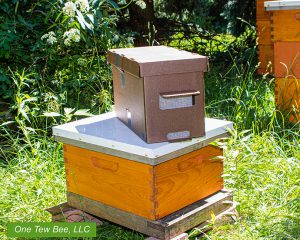
Figure 1. A five frame split awaiting transfer to standard equipment.
There has never been an established bee industry infrastructure for routinely producing and distributing splits. Every season, you and I must search for someone who has decided to split their bee colonies and equipment from their established colonies, provide a queen, and sell these “baby” colonies. The cost in time, and energy from both beekeeper and bees is significant, so the selling cost of the split is always more than the selling price for a package.
In general, I prefer splits over packages, but the split-purchasing and installing procedure can be more complicated and costly than the simplicity of package usage.
In all my years of buying packages and splits, I have found that for me, personally, the confusion is in the details. What details? Well, there’s quite a few. In no order of priority, I would like to review some of these characteristics below.
Detail #1 – Split vs Nuc
Splits and nucs are essentially the same bee hive component, but not exactly. In my opinion, a split is a type of nuc that is intended to grow into a fully functional colony. That can’t be said of all nucs (aka nucleus hives or nucleus colonies). For instance, some nucs are only intended to be a component of queen production. They will never grow to full-sized colonies. Other nucs have specialty functions such as populating an observation hive or possibly being used as a component of a colony cut-out procedure (removing a bee colony from a building). Various sizes and components of nucs frequently have significant use in the scientific community and research organizations. A nucleus hive is frequently just for the moment.
In a way, a nucleus hive could be said to be comparable to a cutting taken from a plant. How big was the cutting? How was the cutting rooted? When, during the season, was the plant cutting taken? A nucleus hive is just a bee colony “cutting.” Details and specifics abound.
Detail #2 – Where to find a split colony purveyor?
A few paragraphs ago, I wrote that a nucleus hive is frequently just for the moment. In a way, I want to write that finding someone to sell you colony splits is also for the moment (or season). I ask around. I have contacts from previous seasons. I read advertisements in journals and newsletters. I see online messages. In general, I try to make good luck happen when searching for a producer. In a few instances, the producer was actually just doing me a favor and was not in the split-producing business. In fact, only in a couple of instances have I purchased splits from the same person more than two consecutive seasons. Why? Let’s go with that discussion in Detail #3 below.
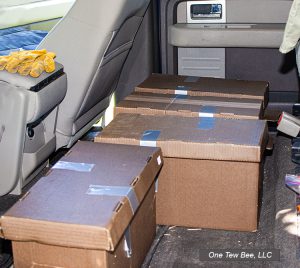
Figure 2. Paper nucs boxes filled with a colony split ready for the ride home.
Detail #3 – Why produce splits for sale?
There is no single standard reason that jumps out to me that justifies someone splitting their colonies. Monetary income is the clear and present reason, but that is always hard-earned money. Other than money, it could be local reasons. Maybe the beekeeper who is interested in selling splits is in an area that provides good early Spring buildup and is followed up with a good main nectar flow. They have bees, but those bees do not make a lot of honey. So, they sell bees and not honey.
A producer may be trying to prevent upcoming swarming behavior. To limit that behavior, the beekeeper simply removes some of the bees and brood from the brood nest. Maybe the beekeeper has more colonies than can be maintained. Maybe the beekeeper is interested in doing something different that will provide a needed flush of extra income.
Bottom line? I don’t know exactly why someone decides to produce splits for sale. Other than large production companies that have management sophistication beyond that of a typical beekeeper, most split producers have limited production capacity and are local. In my bee life, providers vary from season to season.

Figure 3. Nuc boxes improvised by cutting a deep hive body in half. J. Kerns photo.
Detail #4 – What am I paying for?
You are paying for whatever you have negotiated. Unlike three-pound packages, there is no “standard” split. Three, four or five frame splits are common. The producer should tell you how much honey, pollen, brood and bees will be in the split. Yes, you will probably be buying the beekeeper’s older combs. In some instances, you will want to phase them out as soon as possible.
Nowadays, producers rarely require the frames and equipment to be returned to them. The equipment is included in the selling price. It becomes yours. Being an old guy, I can tell you that in decades past, I was required to provide new frames and foundation and to return the nuc box, but mites and viral diseases have put a damper on that requirement. Though it surely increased the selling price, not requiring equipment replacement made the split transition simpler.
Throughout this entire encounter, if the provider is marketing to others and not only doing you a favor, be sure they are inspected by the state apiarist and are approved for selling “baby” colonies. In fact, you want to know that answer even if the provider is a friend who is trying to help you out. Without a doubt, you are going to be buying varroa mites in the deal but you do not want to be buying American foulbrood, too. Always be alert.
Detail #5 – Speaking of nuc boxes
In what kind of box do you transfer the split to your home yard? For sure, ask that question during the transaction period. I have had experience with two broad types of transfer boxes – wood and temporary (paper or corrugated plastic). I felt best about the wood boxes but acquiring a permanent five-frame wooden nuc box obviously increased the selling price. Years later, I still have several wooden boxes in my bee operation that I acquired from various nuc-split deals.
Wax-coated paper nucs are popular as temporary bee hive boxes, especially for splits. In my mind, I live in a perfect bee world, so in that perfect world, I plan to bring these small colonies to my home yard and immediately transfer them to standard equipment. There, they will live happily ever after. However, the following saga describes what happens in the real bee world.
I bought about twenty five-frame splits from a respected provider about one hundred miles from me. I made the trip and loaded the splits onto a small, open trailer. Using common duct tape, I attached the lid to each paper box and then ratchet-strapped rows of boxes to the trailer. Of course, it was going to rain on me and my new bees on the trip home. It did.
Upon arriving at home, I found that on two boxes, the dampened lids had bent back – due to the wind velocity – and had exposed the internal colony to highway wind speed. I essentially scattered some bees up and down the interstate. Worse, one lid was completely gone. I still had some bees in the open boxes, but the populations had been reduced. But the story does not end here.
After I arrived at home, the weather prediction only grew worse. I hurriedly got the boxes set up in my yard and placed a brick on each corrugated paper colony. After getting back to my easy chair at home, it became official. Within a few hours, a storm was to pass through my home town with high winds and heavy rain. Back to the yard I raced, with a different enclosed box trailer that was not truly road worthy. I hurriedly placed the colonies within the enclosed trailer scattering bees everywhere. As I was working, I took a second to wonder if the high winds would now destroy both the bees and the trailer.
The storm passed. The trailer, and the protected the paper-housed hives, survived without incident. The next day, I got the bee splits set out again and transferred to them to standard equipment. Yep, there was flight confusion and drifting, but ultimately everything settled out.
My point for this long story? When I casually agreed to wax-papered nuc boxes, I did not envision a rainy drive home and subsequent high wind and rain storms before I could get the splits into permanent boxes. As usual, I envisioned a perfect bee world. I suggest that you have a doomsday plan for what to do if things do not go as planned.
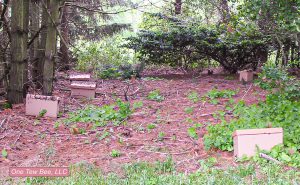
Figure 4. Some of the paper nuc boxes the next day. I left lids askew to aid lost bees in finding a home.
Detail #6 – All things queen-related
No doubt, the reason more beekeepers do not produce splits is queen availability needed to head the splits. Yes, some rarified few beekeepers are set up to produce a few queens of their own, but many of these producers must buy queens at a time when they are most in demand. The type and caliber of the queen will vary from producer to producer.
Honestly, this is difficult to put into practical wording, but I must try. Your goal with this split is to get the colony established. In the real world, your primary requirement is that the queen’s ability is great enough to establish a successful brood nest and stabilize the colony with her pheromone output. I would suggest that if she is able to do that, the producer has met their obligation to you.
In the perfect bee world, you would get a high-dollar, fancy-bred queen that would lead the young colony to population greatness in a short time. In the real world, you just hope to get a queen that can lead the young colony to accumulate enough colony resources to survive the next Winter that is still months away. In my case, I am only trying to get the small colony stabilized. Once the split colony is on firm survival ground, I may then decide to upgrade the colony’s queen leadership.
What’s to prevent the provider from selling me an old queen? Honestly, not much. The good news is that the provider will probably not have a large inventory of old queens. But while I don’t really want a queen that’s already approaching her supersedure time, if she is productive enough to stabilize the colony and importantly, if the colony’s worker bees have shown that they are okay with her, then so be it. I just wrote before that I may very well be considering replacing the queen anyway. Even a new, young queen may be superseded by finicky nurse bees. Nothing is assured. At the risk of repeating myself, I feel that the primary goal is to get a stable, established colony that I can work and manage as it develops into a full-featured colony.
Detail #7 – The season
If the split provider let the baby colony produce its own queen, then I and my new bees have already missed the early Spring nectar and pollen flow. That part of the season had to be used to grow the queen. I need to be prepared to feed this young colony as it tries to accumulate enough resource wealth to Winter its first major dearth. To assist this small colony, in addition to supplemental feeding, I will need to perform all the beekeeper assigned tasks like varroa control and small hive beetle suppression.
The queen’s output and the season are interrelated. Sometimes the queen just does not work out. If you have enough of the season remaining (you must decide that answer), then replace her. If the season has progressed to the typical Summer dearth – or even into Autumn – you and your new colony may be better off to pass the Winter with a subpar queen leading the colony. Hey, no one said beekeeping was always easy.
Detail #8 – Failure
What recourse do you have if the splitting project fails? Honestly, not much. I am not defending producers, but many things and seasonal events are beyond their control but it’s not just about failed splits. What recourse do you have if a package project fails? Not much. Are all hived swarms successful? No. As you know, there are no guarantees in any aspect of beekeeping.
If you truly feel that what was in your nuc box when you got home was not what you negotiated, certainly you can complain, but I doubt much will come of it. I am sure you will not return to that provider next season and I also expect that you will quietly let others know of your negative experience. I feel a need to say that I have never been given a split that seemed to be significantly less than what I bargained for. No doubt, some of you have other stories.
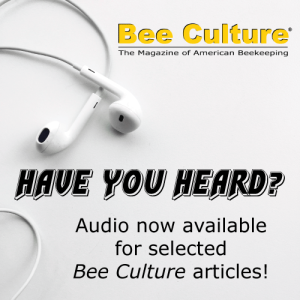 Have you heard Bee Culture magazine?
Have you heard Bee Culture magazine?
By clicking on the computer code (QR Code) at the beginning of this article, you can go to Bee Culture’s audio-article web page. In the audio version of my article, in addition to my monthly article, I have posted extra comments and details that I don’t have space to address in written form.
Have you heard Honey Bee Obscura?
Some weeks ago, Kim Flottum and I posted a podcast at HoneyBeeObscura.com where we discussed conversational aspects of buying and managing splits. It’s free. Have a listen.
As always, thanks for reading (and listening).
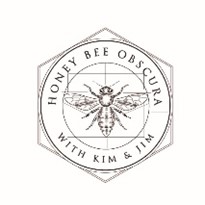 Dr. James E. Tew
Dr. James E. Tew
Emeritus Faculty, Entomology
The Ohio State University
[email protected]
Co-Host, Honey Bee
Obscura Podcast
www.honeybeeobscura.com
Click Here if you listened. We’re trying to gauge interest so only one question is required; however, there is a spot for feedback!
Read along below!
For the Eager Honey Producer –
The Classic System of Two-Queen Colony Honey Production
An old technique for the modern mega-management beekeeper
By: James E. Tew
Beekeeping then and now
Happily, beekeeping has kept up with many modern-day advances, but that evolving characteristic means that beekeeping today is not the same as beekeeping was many decades ago. Advances in protective equipment, improvements in honey processing equipment, introduction of new pest complexes and large migratory operations are only a few of the myriad of changes that have been occurring in our beekeeping industry.
I surmise that one of the biggest changes is that modern beekeeping is now primarily known for pollination while honey production is now the second factor for which beekeeping is known. That is exactly opposite of what beekeeping priorities were thirty or so years ago.
In the golden years of beekeeping past, honey production was the Number 1 goal of dedicated beekeepers. Nectar flows determined the beekeeper’s management schedule and then, when possible, supplemental pollination services were sometimes provided. In many instances, neither the grower nor the beekeeper felt that it was financially feasible to use added honey bee populations. That concept has radically changed. Priorities have evolved.

Figure 1. A post card from Amasa Holcomb, Southwick, MA, that was sent to Dr. C.C. Miller in 1883. Note that 300 pounds of comb honey were produced in 1882. There was no mention of extracted honey.
As a young beekeeper all those years ago, I was familiar with the beekeeping priorities of the day. Yes, even then, liquid honey ruled, but even that emphasis was a change from what honey production was decades before my time. I roughly estimate that eighty to one hundred years ago, comb honey was preferred to liquid honey because it could not be adulterated with sugar syrup. Comb honey was “pure.” Books were written about comb honey production. Talks were presented at meetings. Techniques abounded.
While comb honey is still produced in newly developed plastic containers, the old tried and true way of producing honey in basswood section boxes has seemingly died a long, slow death. Basswood boxes for comb honey production are only available from a few remaining vendors – if you can find them at all. The loss is not horrendous, but it is significant.
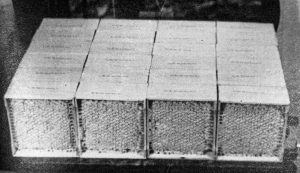
Figure 2. Basswood section boxes of comb honey. C. Killion photo, 1951.
It always bothered me that perfectly good nectar sources – basswood trees – had to be harvested to produce the unique wood that would bend into a box shape. But in obvious ways, moving from basswood boxes to plastic containers has only brought us different challenges. I suppose that could be a discussion for another time, but not today.
My belabored point is that beekeepers once produced comb honey in basswood boxes and now we don’t. That technology is gone. That’s a big change that took decades to develop.
An aside…
In this vein of bee things that are gone, a rarely lamented change is the move from 60# metal tins to common white plastic buckets. The tins could be tightly stacked on a truck while round buckets do not stack tightly. But current plastic buckets have more comfortable handles than the small metal handles on honey tins. But you should know that the change was rapid. It seems to me that in just three to four years, metal tins were dropped from catalogs to be replaced by plastic buckets. Now, I can’t even find a photo of a honey tin on the web. Things change. They always do.

Figure 3. Double crates of honey tins. Each crate weighed 125 pounds.
The classic double-queen system of honey production
Everything I have written in this article, has been to get to this point. Why write about a dated technique that few modern beekeepers still use? It was the rage then but as with basswood comb honey boxes and metal honey tins, things change. But if you have the energy and the interest, this is a technique you can still use in your bee operation.
When I began beekeeping, one of the advanced concepts was to use two queens to build up an abnormally large population of worker bees just in time for the nectar flow. Just as the flow started, the colony, that had two queens, whose brood nest was separated by a double screen or a modified inner cover, produced a double bee population. Excessive honey crops were the desired results.
A disclaimer…
I have not tried to manage bees in two-queen colonies in about thirty-five years. Readers, due to my current energy and strength capabilities, I doubt that I will ever try again. Never in my entire beekeeping career have I been an accomplished two-queen beekeeper, but all the advanced beekeepers were giving it a try. Talks were presented at meetings. Success stories were staggering. You had to be there. At this moment, I do not know a single two-queen beekeeper. But in its day, this management scheme was widely touted.
To put this article together for you, I relied heavily on the pamphlet published by C.L. Farrar in August, 1958 (Farrar, C.L. Two-Queen Colony Management for Production of Honey. ARS-33-48. Available in archival form at: https://archive.org/details/twoqueencolonyma48farr/page/4/mode/2up).
Quoting Farrar from his work,
“Two-queen colony management represents an intensive system of honey production designed to obtain the maximum yield from each hive. During any short honey flow (about two weeks) one large colony will produce more honey than two or more smaller colonies having the same aggregate number of bees. In single-queen colonies the production per unit number of bees increases as the number in the colony increases up the maximum (60,000 bees). This efficiency relationship remains high when populations are further increased through the use of a second queen. Because small colonies increase in population with time, their production efficiency over long honey-flow periods will rise. However, colonies with large populations throughout either long or short flow produce the greatest amount of honey, because their efficiency is high over the entire honey-flow period.”
To emphasize his point, a large population of bees will produce more honey than the same population housed in two or more hives. Getting an abnormally large bee population – before the flow started – was the reason for using a second queen.
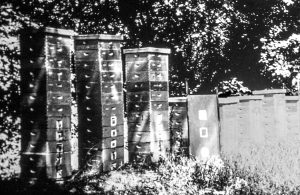
Figure 4. An old photo comparing two-queen colonies with standard colonies. The small colonies were in bright sunlight while the tall colonies were deeply shaded. My photo editing skills were stressed.
Everything about the double queen system was big. Big bee populations, big (tall) colonies, big honey and pollen crops, and big management inputs. The results were to be big honey crops with powerful colonies passing into the following Winter. A five-hundred-pound crop (yes, 500 pounds) was not considered impossible when using this technique. A fully functional double-queen colony could have the amazing population of twenty-five to thirty pounds of bees in it.
It’s all in the management details
Pollen reserves
In 1958, our industry had not yet developed artificial pollen products. At that time, to produce large bee populations, a beekeeper would need extensive pollen sources. Obviously, your colonies cannot produce brood without pollen. That same pollen reserve later became important to wintering colonies. The desire was to produce large colonies going into Winter to have strong colonies for the two-queen system during the next season.
Queens
For this system, queens need to be purchased and be readily available. In 1958, they were and the cost was not as great as today. You should be wondering if allowing the split part of the colony to produce its own queen was an option. The is answer is, “not really.” While it clearly could be done, valuable seasonal time would be lost while the bees were growing queens and not growing a worker bee population. It would seem to me that modern two-queen beekeepers would be confronted by queen availability during the early season of the year.
Hive equipment
Two queens with a double worker population naturally results in a tall hive. Due to that fact, the two-queen colony would need to sit on a firm foundation that was essentially on the ground. Hives that were seven deep boxes tall were not uncommon. Hive stands would not be used.
To forestall bees storing honey in the valuable brood nest area, supers were never allowed to be more than half full. As boxes were filled, they were removed and processed and then the wet equipment was returned to the tall hive.
Other than purchase costs and assembly labor, shallower equipment was not held in disfavor. The reduced weight of full supers was the obvious reason. But a lesser-known reason was that some researchers felt that bees wintered better in shallow boxes. It was felt that bees’ wintering cluster had more interactive space to share Winter food stores in the spaces between the boxes. In fact, Dr. Farrar wrote, “The size and shape of the hive units have little effect on production if enough (boxes) are used for brood rearing, food reserves, and the storage of surplus honey.” That is an interesting observation that goes beyond this honey production discussion.
Farrar added the comment that the most efficient management was possible when all brood boxes were uniform and therefore interchangeable. The same would be (mostly) true for super sizes.
Shallower supers were preferred to deeper supers. Apparently, bees fill and cap the shallower equipment faster than deeper equipment. Again, weight would be another prime reason for using shallow equipment.

Figure 5. The position of the two brood nests in a full functional two-queen system.

Figure 6. Late season two-queen system with brood nests combined and excluders removed.
Management points
To produce stronger colonies, you need to begin with strong colonies headed by young queens. Weak colonies had no place in the two-queen system. Make everything large. Beginning five to seven weeks before the flow, begin the two-queen development process. Two weeks later, make a strong divide from the original colony and either use a double screen or a screened inner cover to separate the split from the parent colony. In his paper, Farrar provides intricate details for quantities of brood and bees that will need to be moved to different locations with the developing mega-hive.
After the new queen was installed and was producing copious amounts of brood in the split above the screen inner cover (usually ten to fourteen days), the screened inner cover was removed. The colonies were kept separated by queen excluders.
Empty brood nest space was provided above the lowermost colony. A queen excluder was used above the bottom colony. This was a necessity. At this point, the beekeeper had a strong queen in the lower unit with an empty box of drawn comb (preferred to foundation) atop of the lower unit. The extra space allowed for continued brood production.
Above the lower queen excluder was the recently introduced queen with a second brood nest with a similar configuration of brood and empty brood nest space. Then yet another queen excluder was put above the second top colony between the top brood nest and the supers. The dual queen excluders confine the queens to their respective spaces and became an aid to keeping up with the two queens when the colony was opened to remove full supers and for inspection.
Most of the surplus honey storage occurred above the second colony in the top of the tall colony. Again, it is important to write that the supers were inspected and additional space was added when supers were only 50% full. The intent was to discourage the bees from storing honey in either brood nest area.
Swarming and supersedure were not thought to be any more relevant than swarming and supersedure in single-queen colonies. If swarming was becoming an issue in a two-queen unit, the recommendation to use the “shook swarm” technique to attempt to get things back into order. That sounds like a management headache.
Not a technique for colony increase
As I began to write this piece for you, I envisioned the two-queen system having the possibility of ending the season with two colonies. While I feel that could still be accomplished, Dr. Farrar discouraged using this two-queen system as a technique for making colony increase.
Indeed, as the season ended, he suggested just removing the excluders and allowing the bees to select the better queen. Presently, the current cost of queens would be a hinderance to that recommendation. Having a $40 queen only produce for a single season feels extravagant. However, outside of the two-queen system, this general setup could be used to assist a “weaker” colony in becoming stronger but is a totally different discussion.
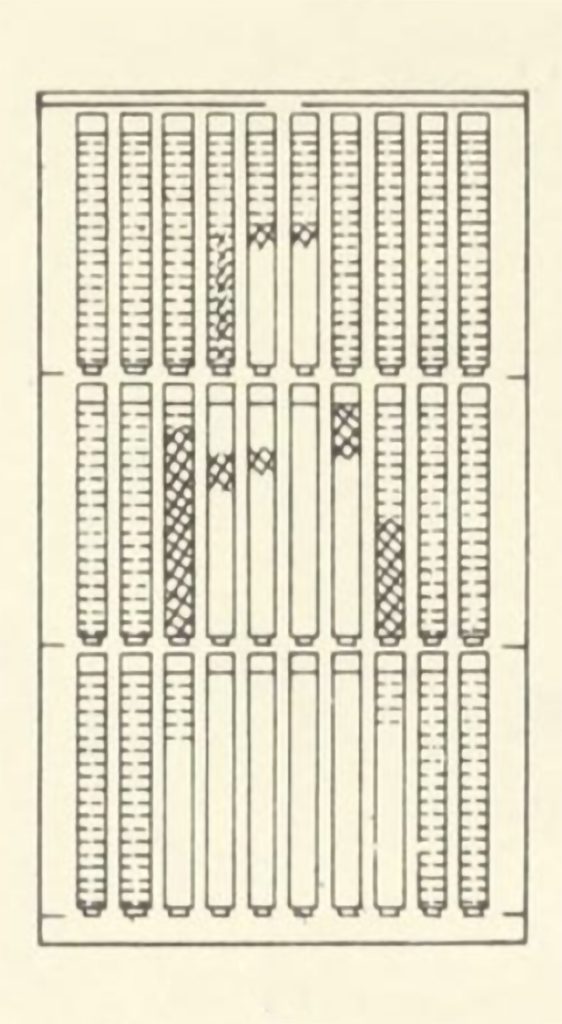
Figure 7. Former two-queen system
prepped for Winter.
The reason for this recommendation of not using the double-queen system for colony number increase was presented in his summary included in his paper. “The larger pollen reserves accumulated after the colonies have been reduced to a single queen status make it possible to overwinter stronger colonies for the next season.”
Times have changed. I extensively discussed that. Does the development of modern pollen supplements obviate some of the old two-queen management recommendations?
This is not for the faint-hearted
After my experience all those years ago and after reviewing my sources for this article, I can clearly write that this is not a management scheme for all beekeepers. Only those beekeepers with the time and the penchant for intensive colony management should take it on. The payoff is great, but so is the labor and monetary input.
Then why bring it up?
Like so many other things and recommendations within beekeeping, managing bees for a double queen scheme is an idea dating back to the 1930s. Does it still work? It certainly worked at one time, but I can’t speak for the present.
In the 1950s, herbicides were nonexistent. Queens were available and were not as costly. Honey was the Queen of Beekeeping. But we now have ready access to pollen substitutes and other improvements. So, I bring this subject up for those rarefied few of us who want to push the beekeeping envelope. That will not be me doing the pushing. If you try this technique, I would like to know how it works out.
For more information and instruction, in addition to the reference already provided, I refer you to the sources that I have provided below.
Current information on the two-queen system is included in:
The Hive and the Honey Bee. 2015. Pp 505-507.
ABC & XYZ of Beekeeping. 2020. Pp 679-680
As always, thank you.
If you are still reading, you are one tough beekeeper. A sincere thank you for your beekeeping dedication. I have not been able to do any more than introduce you to this old, advanced concept. I know you will have questions. I certainly do.

Dr. James E. Tew
Emeritus Faculty, Entomology
The Ohio State University
[email protected]
Co-Host, Honey Bee
Obscura Podcast
www.honeybeeobscura.com
Click Here if you listened. We’re trying to gauge interest so only one question is required; however, there is a spot for feedback!
Read along below!
 A Few Unique Beekeeping Tools
A Few Unique Beekeeping Tools
And some other cockamamie ideas
By: James E. Tew
I’ve done this all my beekeeping life
One of my very first beekeeping thoughts when I was first accidentally introduced to beekeeping was, “I can build this wooden equipment.” So, I did. As a totally new beekeeper with above average woodworking abilities, I set up the shop, bought pine lumber, built jigs for making repetitive cuts and went to work. For a couple of years, I even built my own wooden frames. While I was never cost competitive, I got a strange satisfaction from cutting my wooden equipment (Of the hundreds and hundreds of frames, boxes, lids and inner covers that I built, not a single one remains. Not one. I wish I had just one of the pieces that I built. At the time, it was not important. Bummer.). It was my beekeeping project and not something I just bought. I loved doing this work… until I didn’t.
After only about two seasons, the simple construction procedures and the mindlessly repetitive cuts became monotonous. When running power woodworking tools, boredom is a great way to be awarded a trip to the emergency room. In my life, I have made two of those trips, but I am happy to say that I still have all my body parts. I have not built my own equipment for many years now. I still could, but why bother. Been there – done that.
All my beekeeping life, I have looked at non-beekeeping devices and various procedures and wondered, “Could I use that in my beekeeping efforts?” I’m not talking about things like a woodworking shop, a pickup truck, a mobile phone or a good pair of boots. Rather, I am talking about odd items that were never intended for beekeeping use that could possibly be effectively used in my beekeeping craft. Be forewarned readers that much of what follows is half-baked. Only a few recommendations will be made. As it were, “do not try this at home.”
An electric heat gun
I am amazed at how often a heat gun fulfills an unanticipated use, both in life and in beekeeping, but in this article, I want to stay within beekeeping. I have used heat guns to soften heavily propolized frame rests in bee boxes. Quickly heating the gummy propolis makes it significantly easier to scrape and clean. I have used heat guns to quickly liquify small amounts of honey when I was in a rush. I have used heat guns to loosen the sticky bottom bearing in my old extractor. I have used heat guns to clean and sterilize my hive tool. On the web, some of you have described how to use a heat gun to uncap honey. The uses seem endless. But then I became too excited. Could I use this heating device in the beeyard?
So, I set the heat to a level low, and opened a hive and hit the alerted bees with a waft of very warm air. It did not have the desired effect. In fact, it may have even energized the bees a bit. I quickly decided that the idea was one for the beekeeping idea trash heap. I rolled up the extension cord and put the gun away.
But wait. I just saw in an advertisement, that major heat gun manufacturers are producing battery-powered units. No extension cord would be required. Obviously, I will be needing one of those.
This is my tentative plan. Next Spring, I want to see if I can use the hot air produced by the battery-powered heat gun to soften the propolis seal on the inner cover when I want to gently open a colony. Secondly, I want to see if I can use the battery unit to soften propolis on the top bars to loosen them without having to pry and bang them from the bottom side. While it looks good on paper, I’ll have to get back to you next Spring. Stand by.
Ratchet straps
Ratchet straps are essentially complicated Bungee Cords . While both are beautiful devices, the ratchet strap is now a significant part of my beekeeping equipment and is listed in some supply catalogs.
. While both are beautiful devices, the ratchet strap is now a significant part of my beekeeping equipment and is listed in some supply catalogs.
Of course, as I have told you time and again, I am no longer a young man. In my youth, when preparing to move hives, the best recommendation that I had was hive staples or the early non-ratcheting version of straps. The non-ratcheting straps were too difficult to tighten and loosened too easily. They failed the test. Staples were a different story. During those times, beekeepers bought staples by the case. There were even instructions on how and where to position the staples on the hive bodies.
An aside…
Many years ago, Trucker’s Hitches were a style of rope knots that were used to tie down bee colonies (and anything else that one wanted to keep from falling from a wagon or a trailer). This tiedown system is even older than staples. Today, video instructions for tying this simple knot are readily available on the web. I have personally used ropes with Trucker’s Hitches to lash eighty colonies for a round trip from Ohio to Florida. This old idea, that greatly predates ratchet straps, is still useful – but rarely used – today.
Installing staples was somewhat comical. Nothing alerted the bees like banging on the sides of the hives as the staples were being installed. Envision this scenario. So, there we were – preparing to move colonies and banging on the colonies to get them agitated before loading them. Then, more banging on the hive when the staples were removed. Staples were not a perfect plan, but at the time, the procedure was the best we had – grumpy bees or not (My Dad took a typically novel beekeeper approach to securing hive parts. He used brick-ties and attached to hive boxes with dry wall screws for securing hives when moving to watermelon
pollination. He used a battery-powered drill to drive the screws. Brick-ties are reasonably cheap and can be used time and again. Just another beekeeper idea.).
An aside…
Hive staples are a historic bee supply catalog sleeper. While I can’t say when they were first offered in bee supply catalogs, I can find them in catalogs in 1931, but not in 1928 catalogs. For sure hive staples have been used in beekeeping for ninety-two consecutive years. In the earliest years, staples were copper coated so they could be used multiple times without rusting. It should be noted that, over time, re-occurring staple use caused considerable damage to wooden hive bodies.
Yet, another staple aside…
Hive staples have been handy for uses other than beekeeping. I have used them to improvise a gate-closing mechanism. They work well as hanging hooks. I have used them for quickly joining two boards together. For the improvisational person, these large staples can provide quick, clever solutions to immediate problems. They can also puncture tires when dropped in the bee yard.

Figure 1. A ratchet strapped hive ready for moving. I had broken the propolis seal, so I also used Dad’s brick straps.
I don’t remember the first time I was introduced to the ratchet strap. Now, I must have twenty of them. I use these common tools for multiple things, but I particularly use them for moving colonies. I always buy the heavy duty, narrow straps.
For heavy colonies being loaded under rough conditions, I ratchet strap the hive components together with a single strap, and then I ratchet strap the whole hive to the hand truck I am using. Propolis is useful in restricting the slippage of the strapped hive components.
They work best if the ratcheting mechanism is in the center of the hive top. Locating the ratcheting mechanism along the side is second best. Letting the hooks hang along the side while the strapping mechanism is still on the top is least desirable. The only quirk? Threading the strap into the ratchet mechanism has a bit of learning curve. You will figure it out. These gadgets are field tested and proven.
The limitation to ratchet straps is the sheer number required for moving large numbers of colonies. They become impractical. These devices would seem best suited for hobby keepers or at best, smaller sideline beekeepers.
Foldable work platforms
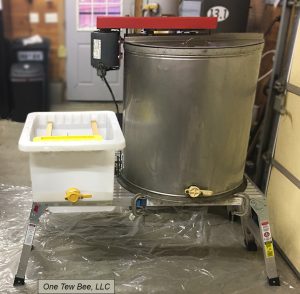
Figure 2. A collapsible work platform used as an extractor stand. Later, to provide a wider platform, another stand was added.
I use two foldable work platforms as a support base for my extractor and settling tank. The platforms tolerate “some” wobble and are stout enough to withstand the weight. Initially, I tried a single platform, but it was too unstable. For a larger working surface, I ratchet strap two platforms together. While not perfect, it is a quick and simple procedure. This is yet another beekeeping item I found at a home supply company.
Snow mats
Beekeepers in warm climates will be at a disadvantage here. For those of you who never see snow, it’s premature to rush out and buy several of these things. Stand by. For those who deal with snow, heated mats seem to cry to be used in beekeeping.
I wrap my extractor tank with these large heating mats. It helps keep the tank barrel warm so that the honey flows to the bottom faster. I was reluctant to put the heating mat beneath the vibrating, wobbling extractor. I was afraid that it would wear through the mats and cause an electrical short circuit.
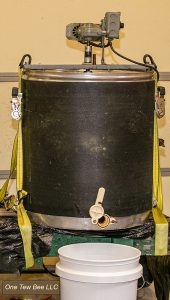
Figure 3. A heated snow mat and ratchet straps for securing the extractor.
I tried putting the mats beneath a large, heavy aluminum flat pan to see if I could use the mats to heat honey supers before extracting. That didn’t work. Primarily, the problem seemed to be that the mats did not produce enough heat.
But what would happen if I put heating mats beneath my wintering hives? I have no idea how that would work, but I continue to be intrigued by my lingering idea. The mats are about two feet wide and about five feet long. There is enough length to have two colonies sit on one mat. This is one of those ideas that works well on paper. Maybe one Winter day I will give it a shot.
An aside…
I emailed the manufacturer of the snow mats and told them I was exploring using their mats in my honey extracting operation and how I was using them. The company did not respond. Later, in response to an advertisement for their snow mats, I sent an iMessage again describing my interest. They did not respond to that message either. Two messages with no response. Don’t you think that should tell me something?
Moisture Meter
I have a moisture meter for determining the water content of wood that I am working with. Of course, I immediately wondered if I could simply put the moisture meter probes in honey and get a moisture reading from the meter. Didn’t work. I contacted the company and they sent a different detecting connector, but I could not make that work either. The scale was not sensitive enough.
Beekeepers, that would be so slick if it would work. Rather than having to load and clean a refractometer, I would only need to put the probes in the honey and – voila – a moisture reading. I have backed away from this use for my wood moisture meter use. Someone else can give it a try.
Pry bars
In my experience with beekeeping, hive tools have come a long way, but still not far enough. If a beekeeper is working a smallish hive that is regularly worked, all is well when using the traditional hive tool. However, when trying to dig out frames from a behemoth colony that has not been opened in a long while, the light hive tools are pushed to the maximum. I have an assortment of larger pry bars – to include a wrecking bar. None were purchased from a bee supply catalog. But be aware that there is an upper limit. When using pry bars with significant leverage, the soundly stuck top bar will rip from the end bars rather than pull the frame out.
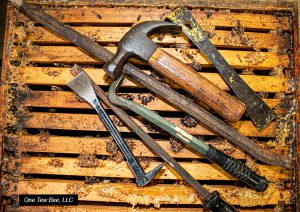
Figure 4. Some of my non-beekeeping heavy duty hive tools. The blue one in the lower left is my favorite.
Propolis-embedded plastic frames are miserable to pull out with any type of hive tool. The plastic flexes allowing the pry bar to break free. Those frames will require being driven out from the bottom of the super. I have a modified short-handled hammer that I use for that purpose. Plus, I can still use the hammer to drive nails and staples.
I’m out of space
There is seemingly no end to this rambling thread, but I must stop.
- I presently use HVAC pads as leveling foundations beneath some of my hives.
- I have wondered if an old, retired sleep apnea air compressor device could be used to deliver smoke or oxalic acid fumes to my colonies.
- A leaf blower can clearly be used to remove bees from supers, but is there some way that it could also be used to deliver smoke to a colony?
- Can the flame from a propane-powered weed killer be used to sterilize wooden equipment or to melt away burr combs and propolis? One day, I will try this device for these purposes.
- I have successfully used a pet bowl heater for providing a Winter water supply for my bees. Wintering birds also greatly appreciated this rare water supply.
- I use a three inch wide scraper with a disposable blade for removing old combs from foundation inserts. I found the scraper at a big box home supply store. Ironically, I use my heat gun to soften the combs before scraping.
- Would a deer cart be more (or less) useful than a typical hand truck for moving a bee hive? I don’t know.
- Could the plastic bags that my newspaper comes in be used as a disposable syrup feeder bag for wintering colonies? I don’t see why not. Presently, I have about one hundred of these bags crying for some bee use.
- Does a mylar survival blanket have any use for the wintering bee colony – especially when used inside the hive. I’m still thinking.
- Archery equipment has been used to string a retrieval line to a high swarm. While I have not personally done this, others of you have. You know who you are. You sent me photos.
What have you done?
Beekeepers are an adaptive lot. If you have novel uses for tools or devices that you would want to share with others, let me hear from you. Clearly, I love cockamamie gadgetry.
Thank you
I appreciate the time you take to read my articles. I enjoy hearing from you. Thank you.
Dr. James E. Tew
Emeritus Faculty, Entomology
The Ohio State University
[email protected]
 Co-Host, Honey Bee
Co-Host, Honey Bee
Obscura Podcast
www.honeybeeobscura.com
Click Here if you listened. We’re trying to gauge interest so only one question is required; however, there is a spot for feedback!
Read along below!
 Dealing with Beekeeper Guilt
Dealing with Beekeeper Guilt
Caused by Reduced Beekeeping Practices
By: James E. Tew
This is not a negative article
While it may sound like it is, this is not a negative article; however, it is a realistic piece. Many articles in Bee Culture Magazine present beekeeping management information that help the evolving beekeeper manage their colonies perfectly. Yes, problems and challenges will always arise, but when they do, some of the published articles explain what procedures would be required to get colonies back to high standards. That’s always the goal – perfect colonies in a perfect yard. It’s a lofty aim.
A “beekeeper” is not a standard designation
The ability and energy of individual beekeepers are all over the page. Few things about us, as a group, are standardized. But to many of the population of this country, who do not keep bees and know nearly nothing about them, being a “beekeeper” is a unique designation. When viewed by this large group, all beekeepers are seen as being the same. Cookie-cutter as it were.
Yet, within our group, there are beekeepers who are on the job night and day, and their colonies normally show the positive results of their energy allocation. But there are also beekeepers who are not able, or inclined, to contribute large amounts of their life’s resources to managing their bees. The colonies of this group may, or may not, show the effects of their laissez-faire philosophy of bee colony management. It’s difficult not be judgmental, isn’t it? It would seem that every beekeeper should strive for perfection beekeeping. I sense that is never going to happen.
It’s not just beekeeping
For instance, as you drive down a suburban street, have a look at the variation of the home maintenance and landscape each house has. Some homes are perfectly manicured while others have not been given the same level of attention. Is one homeowner more deserving of respect than another?
It depends, doesn’t it? Are city ordinances being violated? Is clutter excessive? If homeowner basics are being met, do we not expect some homes to be better maintained than others? Common reasons for this variation are simply innumerable. It’s just the way of things. The same is true with beekeepers.

Figure 1. This dog is a perfect example of a pet.
Bees are not pets
Bees are not actually pets, but they have commonality with pets and other domestic livestock. Obviously, pets and livestock must be nurtured and maintained. In fact, they are protected in many legal and moral ways.
Due to challenges like varroa predation, honey bees are similar to pets and domestic animals. Without human assistance, managed honey bees do not normally thrive. Colony decline and death are the frequent outcomes. So, beekeepers, you need to take care of your bees. But the devil is in the details. Exactly how much care is necessary?
It really gets tricky at this point. Bees are wild animals and, as such, should be able to fend for themselves without human assistance. Yes, that’s true, but feral honey bees conduct their natural lives differently in several notable ways. In the wild, colonies do not normally grow nearly as large as managed colonies and they do not produce as much surplus honey. Plus, they swarm more often. A wild colony provides incidental pollination rather than directed pollination. For instance, you can’t move a feral colony to a commercial apple orchard. And finally – and importantly – they frequently die during the Winter.
At this point, enter the beekeeper and their artificial domiciles. For the bees in managed hives, many things change. Beekeeper care is required to help the colony thrive under these artificial conditions. But again, exactly how much care is necessary?
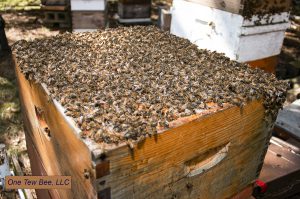
Figure 2. This animal is not a pet, but it is treated as one.
Everything changes
In life’s big picture, everything changes. As we age, many things about our lives change, too. When change comes our way, we adapt. We reallocate. We improvise. We refurbish ourselves. As life’s “things” morph, we do whatever it takes to embrace and incorporate the changes and push our lives forward. We really have no other choice.
Beekeepers and their relationship with their bees are no different. A dedicated beekeeper may not always be able to commit to all the demands that perfection beekeeping requires. Should they quit the craft? No, but they will need to adapt and reallocate the resources they still have.
Sloppy beekeeping
I am not condoning sloppy beekeeping. I feel that I need to write that again – in this article, I am not condoning sloppy beekeeping. But sometimes, try as we might, things change in our lives and our energy and commitment to our bees can seem to approach something that resembles “sloppy” beekeeping.
Job changes, health changes, monetary changes, marital changes or societal changes are examples that can cause a staid beekeeper to have to consider a restructured management level compared to the level they were previously maintaining. Sometimes these changes are temporary while in other instances, they are permanent.
Blended beekeeping
Is what I am naming “sloppy beekeeping” simply “blended beekeeping?” For instance, let’s say that things have changed and we are forced to back down our commitment and contribution to the bees’ way of hive life. If the bees can’t make up the difference, they will most likely die. In my view, this mix of feral schemes with managed schemes could be named blended beekeeping.
Things changed
Okay, it happened. Big changes have occurred. Let’s say the beekeeper retired and had experienced some health declines, but they still are devoted to beekeeping. What are some ways they can adapt and alter their beekeeping protocols?
Be a hobby beekeeper
Bluntly, if big changes are coming your way and you want to stay in beekeeping, you should most likely consider being a hobby beekeeper. Proficient sideline and commercial beekeepers are already being as cost and labor conscious as possible. They live in a different management world and are answering to different management mandates. It’s the hobby beekeeper who can reduce or alter their standards without serious retribution.
The apiary
There are no lawnmowers, string trimmers, and herbicides in the bees’ natural world. That’s all on us. In perfection beekeeping, the grass and weeds are kept mowed and trimmed. Yes, colonies with artificially low entrances will probably appreciate this work, but will uncut grass be the premier reason that a colony dies during the Winter? Probably not. Will the apiary look scruffy and not be photogenic? Definitely.
But if the weeds and brush are allowed to truly run rampant, the beekeeper will nearly be unable to walk to the colonies – much less remove honey or perform colony manipulations. Maybe the recommendation should be to “cut back” but don’t “cut out” weed maintenance.
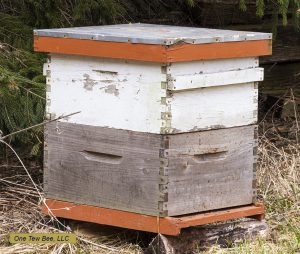
Figure 3. Perfectly functional, but minimally maintained hive equipment.
The hive equipment
Even in reduced labor and energy situations, hive equipment should be assembled correctly. When filled with bees or honey, equipment will surely be stressed as it is moved and manipulated. If you are having strength and health issues, heavy hive equipment will sometimes be handled roughly – even dropped.
Either don’t paint or only paint once and forget it. (That comment is a pain for me to write. My Dad had a paint supply business. I spent my early life dealing with all things paint. Now, I am suggesting that you cut out painting.) Yes, thorough paint applications will help wooden equipment 1Plastic hive equipment, made of expanded plastic foam, should be painted. Otherwise, it’s useful life is shortened.) last a bit longer and it will certainly look better. But really? How much longer will it actually last, or is looking good the primary goal? Maybe the recommendation should be to assemble the equipment soundly but, if necessary, skimp on the protective coatings. Distasteful, isn’t it?
Colony manipulations
Colony opening events can be significantly reduced if labor and energy are to be lessened. After a new beekeeper has acquired the necessary basic skills, whimsically opening a colony is not often necessary. Much can be determined by simply being aware of the season of the year and reading entrance detritus evidence – but make no mistake here. Reducing colony manipulations will limit the beekeeper’s ability to stay intimately aware of the colony’s condition. But the question re-arises at this point – how many colony manipulations are necessary to meet the minimal? That’s an unanswered question. How much are you willing to give up?
Lost swarms
All beekeepers, at all levels, will lose the occasional swarm. Alternatively, sometimes all beekeepers will acquire a swarm that moves into empty equipment or they will acquire a free swarm that they hive. Either way, swarms happen. They come and they go. But reduced colony manipulations will require the beekeeper to be more tolerant of lost swarms.

Figure 4. A good brood frame. When I view this photo in my photo processor, there are visible eggs in the center of comb. I do not need to find the actual queen.
Queen productivity
The more committed a beekeeper is to their colonies’ management, in general, the more anxious they are about the queen stock heading their colonies. Again, being aware of the season, a beekeeper, who has elected to implement “blended beekeeping” concepts should know what a suitable brood pattern would look like during that season. In this way, the investigative beekeeper evaluates the seasonal brood and brood pattern rather than the actual queen. In many instances, no effort, at all, is made to see the queen. Just seeing eggs or seeing the queen’s brood pattern is normally enough for a quick inspection.
I don’t sense a strong argument for the minimalist beekeeper heavily investing in high quality replacement queens. Escaped swarms will most likely be an issue, and they will take costly replacement queens with them. If one is not making splits or is not suppressing swarming and has only a casual interest in surplus honey production, naturally produced queens will meet most needs. For all beekeepers, marked queens are a good idea.
Yes, reducing queen management will greatly reduce time and economic demands. But at the same time, that management pathway will reduce overall colony productivity. Can you – or should you – live with that fact?
Mite management
Like swarm suppression or queen management, Varroa mite control requires time, labor and money. This is a serious aspect of honey bee management. If the beekeeper does not implement a conscientious mite control program, most likely that colony will die and will produce mites that will invade surrounding colonies not yet dead.
Managing mites is one of those instances when the colony should be opened for treatment. There are few ways to cut corners on this issue. If the beekeeper does not implement mite repression programs, then next Spring, to replace dead outs, the beekeeper will be required to purchase bees (packages or splits) from beekeepers who did implement such programs. I can’t see that much money or labor was saved by taking this tact.
Honey processing
Surplus honey removal and processing is a huge labor and energy drain. In past articles, in this magazine, I have written that honey processing is not beekeeping. Indeed, I know a few specialists who only process honey and have few colonies of their own. They contract-process honey for other beekeepers.
In the bright light of reality, capped honey can be taken off at nearly any time of the year – even in the dead of Winter. I don’t know why you would do that since it only makes for a miserably, cold job, but neither do I know your exact situation.
Before extracting, frigid honey would need to be allowed to warm up, but not held too long. Without bees to protect it, that warming interlude gives an opportunity for Small Hive Beetles and Wax Moths to begin damaging the combs. Other than producing comb honey, I cannot think of a way to easily short-circuit the cumbersome process of setting up an extractor and dealing with the folderol that comes from honey processing. I suppose that contract processing would be an alternative.
Dramatically, one could simply leave the surplus honey on the wintering colony. Even for the reduced labor beekeeper, in cold climates, I would suggest wintering the colony in one or two deeps and moving the capped honey supers above the inner cover. In this way, theoretically, the colony could better manage its wintering environment. Honey, held like this, could be used the next Spring as supplemental food for initiating replacement colonies or for giving food to other needy colonies in the apiary.
My point
My point in this piece is there are beekeepers who, for whatever reason, cannot or do not commit to maximally managing their colonies. Representatives from this group are rarely asked to give presentations on their management procedures. There are no articles published in bee magazines for this group, and these beekeepers rarely speak out at meetings. They quietly hang on.
We all have our reasons and procedures that allow us to continue to co-exist with our bees. As I wrote before, “The ability and energy of individual beekeepers are all over the page.” There is no standard beekeeper.
Thank you for reading this piece.
Dr. James E. Tew
Emeritus Faculty, Entomology
The Ohio State University[email protected]

Co-Host, Honey Bee Obscura Podcast
www.honeybeeobscura.com
Click Here if you listened. We’re trying to gauge interest so only one question is required; however, there is a spot for feedback!
Read along below!
 Beekeeping in the United States
Beekeeping in the United States
A review of a classic beekeeping book that is available to you – FOR FREE
By: James E. Tew
Why this book?
Why trot this book out of retirement? Each December, Bee Culture typically features various current honey bee keepers and related scientific and educational staff. I usually choose to tell the Bee Culture readers about beekeeping figures who are no longer with us or are retired from working in our apicultural field, but who at one time, were prominent figures in our industry.
I don’t know why I began doing this, but it’s probably because I am now, myself, a senior citizen beekeeper. I can look backward as easily as I can look forward. During my career, I have had the honor of knowing and working with many, many beekeeping authorities who are no longer with us. About once a year, I say to you readers that “We are standing on their beekeeping shoulders,” and most of you do not even know who “they” were. The authors of the chapters in this book were some of those supporting bee people.
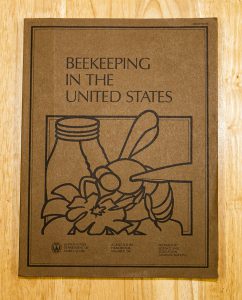
Figure 1. Beekeeping in the United States, Agricultural Handbook Number 335
So, why this book and not some other? It is a quiet classic. Printed copies are still common, but importantly, it is digitized and is available just using simple archival searches. I have provided a URL in the next section. I don’t know whose idea it was to put this text together, but it was an idea for the time. It is a Who’s Who of Agricultural Research Service Researchers of that period. These authors were noted researchers, teachers and frequent speakers at meetings and conventions. They were the “in-crowd” of beekeeping research and information distribution.
This readable book was written before tracheal mites, varroa mites, Africanized honey bees, small hive beetles, neonic insecticides and Colony Collapse Disorder. At best, there were only simple computers and telephones available.
The book authoritatively captures U.S. Beekeeping just before our industry began the “Big Transition.” After the time of this book, everything changed – including the ARS’s research direction. All things beekeeping had to change to keep up with the unfolding honey bee management world.
Abstract of Beekeeping in the United States
Martin, E. C., E. Oertel, N.P. Nye, and others. 1980. Beekeeping in the United States. U.S. Department of Agriculture, Agriculture Handbook No. 335 (revised) 193 p., illustrated. https://archive.org/details/Beekeeping.in.the.United.StatesD7
(Circa 1980) In the United States about 200,000 people keep almost five million colonies of honey bees and produce 200 million to 250 million pounds of honey annually. Beekeepers derive income from the sale of honey, renting of colonies for crop pollination, production and sale of queen bees and packaged bees, and to a minor extent, from the sale of beeswax, pollen, bee venom, propolis and royal jelly.
This handbook provides readers with a better understanding of beekeeping in the United States. Some of the topics discussed are the life history of the honey bee; bee behavior; breeding and genetics of the honey bee; queens, packaged bees and nuclei; managing colonies for high honey yield and crop pollination; diseases and pests of honey bees; and effects of pesticides on honey bee mortality. This handbook also lists beekeeping organizations and some statistics on bees and honey.
Some modern-day beekeeping numbers
Today, in the United States there are anywhere from 115,000 to 125,000 beekeepers. According to the USDA reports, 2.71 million honey-producing colonies in 2020 generated 148 million pounds of raw honey. According to the National Honey Board, per capita consumption of honey in the United States is approximately 1.51 pounds per year (https://www.agmrc.org/commodities-products/livestock/bees-profile#:~:text=In%20the%20United%20States%20there,million%20pounds%20of%20raw%20honey.).
A typical Jim Tew disclaimer
Bee Culture readers, my comments here are not a historical review of the USDA Agricultural Research Service’s honey bee program. Neither are my comments here intended to rank or highlight one individual above (or below) another. There are too many respected people who contributed to this book for me to research and review each one. My comments here are personal and are only selected memories of my interactions with some of these notable individuals. As it were, “This is my story.”
E.C. Martin
Dr. E.C. (Bert) Martin spent most of his career in Michigan at Michigan State University. Later, he served as Staff Scientist, National Program Staff, Science and Education Administration. He was a researcher, copious writer and teacher. At the time of the publication of “Beekeeping in the United States,” (1980) he had already retired. Yet, his contributions appear throughout this publication that I am reviewing. My limited memory of him was as a quiet, pensive man. Yet, he had a profound effect on my personal career.
In 1977, as a young graduate student at the University of Maryland, while being mentored by Dr. Dewey Caron, Dr. Martin notified me that a position in a Commercial Beekeeping training program was about to open at The Ohio State University in Wooster, Ohio. I immediately contacted OSU and began the process of applying.
Upon being interviewed, the OSU review committee wanted to know how I learned of the job opening before it had been posted. I confessed the “heads up” that Dr. Martin sent me. I was awarded the job and went on to work for the Department of Entomology, at Ohio State for about the next thirty-four years. To this day, I feel like my early application submission impressed the search committee as much as my academic credentials. Thank you, Dr. Martin.

Figure 2. Dr. Everett Oertel, circa 1942 Baton Rouge, LA

Figure 3. Dr. Everett Oertel as I knew him in the 1980s.
Everett Oertel
Born in 1897, Dr. Oertel was older than my beloved grandfather. At the Bee Lab in Baton Rouge, I only knew him as a doddering old man, who came to the lab every day and reflected on nearly anything. He spent nearly all his career at the Baton Rouge Bee Lab.
During World War I, he served with the United States 32nd Division in the American Expeditionary Forces in France. He was awarded the French Croix de Guerre with silver star, Presidential Citation and the Purple Heart.
I didn’t know any of this. To me, he seemed to have become the national de facto beekeeping historian – probably due to his age – but I know that in his earlier life, he was a productive honey bee researcher particularly in honey bee metamorphosis.
Even in old age, he was alert and involved in conversational beekeeping. He was committed to all things honey bees. In retirement, he played a significant role in compiling this text. He has been gone since 1988, yet here I sit, reading his contributions to beekeeping in this book. Thank you Dr. Oertel.

Figure 4. Dr. S.E. McGregor, as a young man, circa mid-1940s

Figure 5. Dr. McGregor as I knew him.
S.E. McGregor
In my defense, I met Dr. McGregor on multiple occasions and sat in on several of his presentations, but apparently, I never snapped a photo. I offer the included photos that I found on the internet.
While I do not know details, as a young man in the mid-1970s, I was aware that Dr. McGregor was working on a tome that would list major crop plants and give specifics about each plant, including pollination requirements. It took him years to compile the necessary information and diagrams.
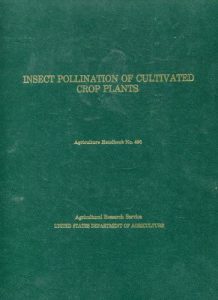
Figure 6. A rare hardcopy of Dr. McGregor’s pollination book
At long last and after many delays, the seminal text was released in 1976. It did not disappoint. Insect Pollination of Cultivated Crop Plants, as a basic information source, is still alive and fundamentally useful today. The updated version can be found online at the citation listed elsewhere in this article (McGregor, S.E. Insect Pollination of Cultivated Crop Plants. https://www.ars.usda.gov/arsuserfiles/20220500/onlinepollinationhandbook.pdf). Additionally, the book is readily available in printed format at bee supply outlets. So, how are these two books related? An abbreviated version of this book was presented as a chapter entitled Pollination of Crops in Beekeeping in the United States.

Figure 7. Jonathan W. White Jr., circe 1958
J.W. White, Jr.
Jonathan W. White, Jr. has the distinction of being the last honey chemist for the U.S. beekeeping industry. He was a prolific researcher and chemist. Dr. White was born on September 29, 1916 and passed away on September 2, 2001. A native of State College, Pennsylvania, and a Pennsylvania State University alumnus, he is recognized for his outstanding contributions to apiculture and honey research during his sixty-year career3.
Go to the web, and key in his name. There will be abundant listings presented on all aspects of honey chemistry and honey handling. In virtual format, his reputation lives on, but today, few latter-day beekeepers know of his contributions.
His co-authored chapter with Landis W. Doner in Beekeeping in the United States, entitled Honey Composition and Properties continues to be foundational information concerning honey chemistry, quality and food value.
H. Shimanuki
What can I say? Dr. Hachiro Shimanuki was a walking, living library of beekeeping information. He knew the general beekeeping literature better than anyone I have ever known. He sat on my review committee at the University of Maryland and was a part of my professional life for many years. Without his permission, I would like to write that he was a significant mentor in my academic life. I have not seen him in many years, but I appreciate all he did for the U.S. beekeeping industry (and for me).
In the book I am reviewing, his chapter was on Diseases and Pests of the Honey Bee. Even in its current outdated format, his information is relevant today. For many years, he was the Lab Leader at the USDA ARS Honey Bee Laboratory at Beltsville, Maryland. If he was not directly involved in a particular study, he was frequently a co-author. A list of his USDA published works is posted at: https://www.researchgate.net/scientific-contributions/H-Shimanuki-45223384
For decades, Dr. Shimanuki, and the lab for which he was leader, was the “go-to” source for any pathological and pest-related bee questions. He attended hundreds of meetings across the world. He was there for the tracheal mite establishment, the varroa invasion and the migration of Africanized honey bees. He was an obvious choice for authoring this disease and pest chapter in the USDA’s general beekeeping book.

Figure 8. Drs. Tom Rinderer and “Shim” Shimanuki (mid-1990s) at the Beltsville Bee Lab in Beltsville, Maryland
Thomas E. Rinderer
Tom Rinderer was the lab leader at the Bee Breeding and Bee Stock Research Center at Baton Rouge. For clarity, this was the same facility where Dr. Oertel, whom I reviewed already, also worked. Dr. John Harbo and so many others also performed research at that facility. Advances in honey bee queen instrumental insemination and breeding were common study topics.
Dr. Rinderer, from this lab, was pivotal in Africanized honey bee (AHB) studies as the U.S. beekeeping industry prepared for the arrival of the AHB. Before my time at Ohio State, Dr. Rinderer was a student of Dr. Walter Rothenbuhler at The Ohio State University where he began developing his honey bee genetic skills.
The chapter that Dr. Rinderer and Dr. Harbo submitted in Beekeeping in the United States is still educational and fundamental today. For those just beginning in beekeeping genetic studies, this simple, readable format, that describes complex breeding strategies, would be a perfect place to start. For example, Russian bee stocks are used in the U.S. industry today due, in part, to Dr. Rinderer’s efforts to select and introduce the stock into this country.
I hate this…
I hate doing this, but I must stop and I must stop well before many other contributors to our knowledge wealth are acknowledged. They’re in the book. Have a look. Their contributions were as significant as those whom I have selected to discuss.
Why this book?
I end where I started. Why review this old book? Because it is a time capsule of the “pre-varroa” way of U.S. beekeeping. Each chapter was written by an authority of the day. It was comprehensive having unusual chapters on topics like Moving Bee Hives or Showing Honey at Fairs. It has lists of nectar and pollen producing plants. It’s a good all-around text.
After 1980, it was never updated. I suppose too many things had changed. The internet was growing. Other organizations were forming. Bee life moved on, but this book, still available to you, remains the same, locked in time. It is not a “how to” book and oddly, it has no index, but it presented some of the best information of the day by some of the best authorities of the time. I like this forty-two-year-old book. Thank you for letting me remember these people and their contributions.

Dr. James E. Tew
Emeritus Faculty, Entomology
The Ohio State University
[email protected]
Co-Host, Honey Bee
Obscura Podcast
www.honeybeeobscura.com
Click Here if you listened. We’re trying to gauge interest so only one question is required; however, there is a spot for feedback!
Read along below!
Some Simple Questions About Bees that I Can’t Answer
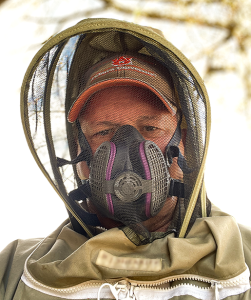 Can you?
Can you?
By: James E. Tew
I don’t know what I don’t know
Increasingly, as I have aged, I have been forced to realize that I do not know what I do not know. I tend to have some of my opinions and beliefs – for the moment. As I gain insight and experience, maybe some of my opinions and beliefs will need to be updated – or even eliminated.
Lazy drones
In my earliest years, I was taught that drones were laggards. They only ate food stores and did not work for the colony good (It is important for you to know that honey bees were wildly plentiful at the time. There was no concern for mating efficiency). In fact, I was told to destroy drone combs in order to keep my colonies at peak efficiency. That notion had to be updated. Drones are a vital reproductive component of a colony. (But wait, Jim. Shouldn’t I remove drone combs to reduce varroa populations?). Don’t go crazy, but four hundred – six hundred drones in a colony and during the warm season are a good thing. The colony wants a “normal” drone population.
Sleepy bees
During my entomology classes in the 70s and early 80s, I was distinctly told that insects do not sleep. Now, it is commonly accepted that insects – and our beloved honey bees – do routinely take naps (Klein, Barret A. and Thomas Seeley. Work or sleep? Honey bee foragers opportunistically nap during the day when forage is not available https://doi.org/10.1016/j.anbehav.2011.03.026). That notion of mine had to be updated.
On and on…
In my high school science classes, I was taught that atoms were the smallest component of all the atomic building blocks – there was nothing smaller. Duh, dummy. What about quarks and leptons? Even the smallest part has smaller parts.
In my third-grade class, my teacher said that we were lucky to live in the gulf areas of the U.S. We would never starve because the ocean had endless supplies of food. Yeah, right. Then later, eggs are bad for you. No, eggs are good for you. Drink coffee. Don’t drink coffee. Jogging is bad for your knees. Well hold on. Maybe jogging is good for you, for your circulatory system. Battery-powered hand tools are a fad. Not anymore. I love them. Latex paint is not as durable as oil paint. I can hardly even buy oil-based paints now. It seems that I am constantly updating and changing. In my old age, I seem to have beliefs and opinions – for the moment.
My beekeeping – for the moment.
Late in my life, my altered perception of my various opinions has affected my beekeeping psyche. So many things – so much science – that at first seemed so solid is now passé. It would seem that there are only a few remaining sure beekeeping havens. For instance, the old me would have boldly said, “Rest assured! You absolutely cannot keep a colony of bees underwater!”
Now, when queried about underwater beekeeping, the current, indecisive version of me would hesitate and ponder. I would probably tell you that this project is going to be very difficult to accomplish, but before I said, “No, you cannot keep bees underwater,” I would now need to know if your hive is watertight, how deep are you considering putting the hive underwater and how long will the colony be underwater? I would be less decisive – but that’s just the new me. (Just to be sure, you do know that I am kidding about underwater beekeeping. Right?)
I don’t know
There’s not a day in the year that I don’t think about bees. After so many years and so many thoughts, I should really have this bee thing down now. Right? No, I do not. If anything, I have gone the other way. I did not realize how much I did not know. What follows are just a few examples of some of my presently unanswered beekeeping questions. Clearly, unanswered questions will always be with me.
Why do a few bees forage for water on cold days?
That whole business about bees clustering at 57°F is probably generally correct, but I can readily tell you I have had a few water foragers at my water source when the temperature is in the upper 30s. These foragers are (seemingly) nearly suicidal. There are only a few of them, so either the tiny amount of water is consummately valuable back at the nest, or they are really bad at foretelling the weather.
The books commonly say that house bees gather in-hive condensed moisture. What if there is none? What if I did a good job of ventilating the hive – as I have been instructed to do? Should we be providing in-hive water for our wintering colonies? I have never read that. Why are these few foraging specialists so crazy for this Winter water? I don’t know, but while I am nearly on the subject, consider the next question.
Why do bees frequently drown in my waterers?
Every day, I find bees drowning in my waterers. Before you tell me, I know that floats would help – I guess. I need to write that bees will still drown even if I have floats present. Even so, I am sure they would help. But what about colonies located near natural bodies of water? Are water foragers drowning in similar numbers at those sources? Some bees seemingly misjudge the water’s surface and plunge in. Over the years, I have saved – probably – several hundred. Is the polarized reflected light from the water? Are the reflective shadows confusing? Do these possibilities even matter?
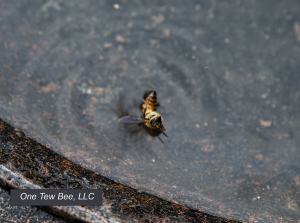
Figure 1. A water forager that misjudged an amphibious landing.
I have seen this time and again. A bee misjudges and lands in nearly freezing water. They only have a few minutes to get out of that cold water or they quickly become comatose, but interestingly, they can live for hours and hours in that cold water. I have taken them out, warmed them with my breath and sent them on their way. Why are they taking these dangerous foraging trips, and why did they misjudge the landing? I don’t know.
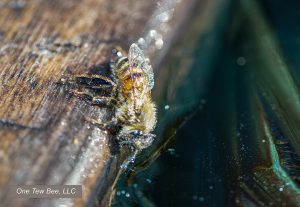
Figure 2. This frost-covered bee must have really been thirsty. There is a thin film of ice on the blue/green water to the right.
Should I whimsically reposition frames?
As beekeepers, we all do it. When we manage our colonies, we move frames to different positions within the hive. Should we? I know a very few of you number your frames and put them precisely back where you got them, but most of us don’t always do that. Colony management is filled with variables. What if it is for the greater colony good?
In natural colonies, combs are built and are never moved. Over time, the brood nest may be moved to different locations within the nest cavity, but individual combs stay in the same position.
How much does it affect the natural organization of a colony to have brood and food frames moved about within the hive? I don’t know. So long as I am not breaking up the brood nest and I’m keeping the honey in (seemingly) proper areas, I will continue to do it. But I will always wonder how much this comb movement disrupts the organization of the colony.
Do foundation inserts affect wintering success?
Roughly measured, the midrib of natural comb may be something like a thin sheet of newspaper or about .004” thick. The midrib of a foundation insert is about .03” or about eight times thicker. Overall, if I include the shallow pre-formed cell walls, a foundation insert is nearer to ⅛” thick.
Wintering bees put their heads in cells within the nest area to generate heat. Other bees that are not in cells surround those heat-producing bees to insulate them and hold the heat in the cluster. Does that significantly increased midrib thickness require wintering bees work harder producing heat?
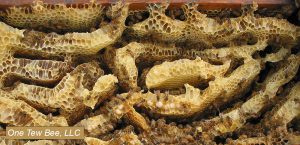
Figure 3. This is the way the bees like their lives.
I am suggesting that wintering bees with their heads in natural wax cells – remember that their heads are the warmest part of their bodies – are very nearly touching each other – head-to-head. All that separates their two heads is a beeswax film thinner than the thickness of a sheet of newspaper. Yet, I put in a barrier that is eight times thicker to separate the several thousand bee heads and that are now much more separated. I sense that the bees must work harder, but just how much? Beekeepers, does this minuscule point matter in the wintering scheme of things? I don’t know. But that leads the next similar question.
Are nice, straight combs good or bad for the bees?
Straight combs are a fundamental requirement for modern beehive management, but I cannot tell that the bees have ever liked them. Believe me, younger beekeepers, you have no idea how much time was required to assemble wooden frames, install eyelets, wire those frames, install beeswax foundation and then electrically embed the wires into the wax foundation – ergo – I love, just love using foundation inserts.
But what did the bees give up to live in our new, improved concept of what the hive interior should look like? Not only are comb midribs much thicker, but the long straight combs don’t seem to be conducive to housing a tight, efficient Winter cluster. A wintering cluster on straight frames is essentially composed of several smaller, separated wintering clusters. The frames are straight and there is no way for wintering bees to intermingle within the overall cluster – but only their small part of it. Would bees Winter better in a nest of their design with combs weaving and twisting in seemingly random order? I don’t know, but I do know that I like straight combs.
Smoke effects
Smoke effects on you and me
“Smoke may smell good, but it’s not good for you. The biggest health threat from smoke is from fine particles, also called fine particulate matter or PM2.5. These microscopic particles can get into your eyes and respiratory system, where they may cause burning eyes, runny nose and illnesses, such as bronchitis.” (Wood Smoke and Your Health, Environmental Protection Agency https://www.epa.gov/burnwise/wood-smoke-and-your-health#)
I grew up outdoors. Campfires were common. Burning piles of Autumn leaves were the norm. In my earliest years, my great grandparents actually burned most of their trash. Everyone had a burn pile. Fire and smoke were common. If you build a fire, then there will be smoke. That was the beginning and end of that. Smoke smells hanging in the air of my early life were common.
I became a beekeeper and was immediately introduced to the basic tool that is older than the classic hive tool – the bee smoker. I saw nothing novel about that. All I had to do was build a small, smokey fire in a bellows-assisted canister. I was told that smoke forced bees to engorge on honey in preparation for departing their burning hive. At the time, I bought that fairy tale. It was only later that I began to wonder what would happen to the fertile, heavy queen that would be essentially unable to fly with the departing bees.
Things change. Then the reason morphed to the explanation that the smoke masked internal hive pheromonal systems and that bees could not amass an organized defensive response. That’s pretty much where I am now, but that explanation still has holes in it. Why would masking pheromones with smoke make bees engorge on honey? I don’t know.
Smoke effects on the bees
What are the effects of smoke on bees? I don’t know. I do know that it “calms” them or does it just confuse them? I do know that I could not work a testy bee colony without dependable quantities of smoke. So, the use of smoke on bee hives is seemingly not going away any time soon. It’s too valuable as a management tool.
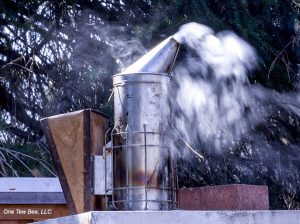
Figure 4. A classic bee smoker – on the job generating smoke.
Honey bees are tropically derived insects. Fire and smoke have long been a part of their natural world. Does that relationship imply that smoke is in any way good for bees? I don’t think so. I suspect that smoke is deleterious to the respiratory system of bees just as it is for my respiratory system. How bad – I don’t know.
Smoker fuels
The list of potential smoker fuels used in this country and around the world is huge. It would seem that nearly any product that can be burned has been used for smoker fuel. Burlap, leaves, wood shavings, cow manure, rolled corrugated paper, cotton cloth, punky wood, sumac pods and wheat straw are examples of fuels that beekeepers have used in their smokers. Is any one of them better (safer?) than any other? I don’t know.
Years ago, I communicated with a respiratory specialist who kept bees. He had invested some intellectual energy in analyzing smoke fuels and felt that smoke from wheat straw had the least amount of byproduct volatiles. I generally use wood shavings in my home yard when applying smoke and pine needles, that are readily available, when I am in my remote yard.
But the use of pine needles as smoker fuel, though used all over the southeastern and Midwestern U.S., is apparently problematic. Csinca wrote to me saying, “We talk, write and read about the compounding multi chemical exposure (including pesticides, pollution and pest control chemicals). Do you want to add something to that with your smoker fuel too? The pine oil itself has more than 23 chemical compounds and combined with the high temperature in the smoker, the outcome will be highly unpredictable, but for sure won’t help the bees.” (Csinca, Tibor. 2015. Personal Communication. Forestry engineer and hobby beekeeper.) Now, I am considering eliminating a common smoker fuel – pine needles – from my common smoker fuel list. Another change?
When I am conscientiously working colonies and expect to be in them for a while, I now wear a respirator to protect my lungs from the smoke. I have the remnants of childhood asthma and I instinctively do not like breathing smoke. However, I have noticed that after a long day in the bee yard, my unprotected eyes are also irritated. Did the smoke do this, too?
In any case, I would suggest using billowing white, cool smoke and only use as much as is needed to subdue the colony. Rather than apply a lot of smoke a few times, I try to use a little bit of smoke frequently. Is this the right thing to do? I don’t know.
It’s not just beekeeping
Believe me, it is not only beekeeping that seems to have endless unanswered questions. I have many, many unanswered questions about topics that are non-bee related. The side effects of medications that I am expected to take, what foods are safe for my general health and am I exercising enough are some quick vague questions to which I do not presently have answers. It would appear that questions, without obvious answers, will always be with us.
Thank you
Thank you for making it this far through this piece. I always appreciate your time and thought.
Dr. James E. Tew
Emeritus Faculty, Entomology
The Ohio State University
[email protected]
 Co-Host, Honey Bee Obscura Podcast
Co-Host, Honey Bee Obscura Podcast
www.honeybeeobscura.com
Click Here if you listened. We’re trying to gauge interest so only one question is required; however, there is a spot for feedback!
Read along below!
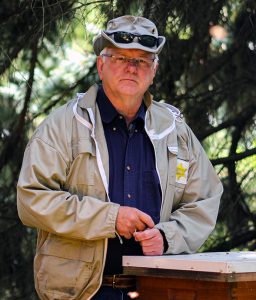 Honey Bee Husbandry in Plastic Hives
Honey Bee Husbandry in Plastic Hives
Surprisingly, beekeepers have a long plastic hive history.
By: James E. Tew
It seems to me
We all have our reasons that determine what we house our bees in. Our ancestors used box hives and the occasional skep. In all my bee life, I have primarily used ten-frame, wooden equipment. I use that kind of equipment simply because I have always used it. Some of you use eight-frame equipment. Others are eager to use top bar hives or other such related styles.
Many of you even use various types of plastic hives that are offered in multiple sizes and chemical configurations. Plastic bee hives – in one form or another – have been presented in supply catalogs at least since the late 1960’s. Honestly, plastic hives cannot really even be called a new idea.
Wood and wax
I’ve always been a wood guy. The odor of new pine wood blended with the smell of beeswax has always pervaded my beekeeping life. As the years have passed, increasingly, that smell always took me to beekeeping. Even now, the smell of newly milled pine brings back pleasant memories of new wooden bee equipment. And, of course, the odor of beeswax and combs is the classic aromas of bees’ world. These blended odors are the very essence of olfactory beekeeping.
Ironic to admit to you that I have been a woodworker longer than I have been a beekeeper. So, If I am so committed to woodworking, and spent several years building all my hive parts, why do I have any interest in plastic bee hives? Short answer – I really don’t know, but please don’t stop reading yet. I think I can explain.
Readers, this is not a comprehensive history piece…
While I believe that a thorough review of the decades-long plastic displacement of nearly everything wooden or metal in beekeeping would be interesting, that endeavor is beyond my ability and certainly beyond my space limitations here in Bee Culture. In this article, I will only be referring to plastic beekeeping events that have influenced me personally, and in fact, continue to affect me to the present time.
The Walter T. Kelley Bee Supply Company and plastic hives
I mean no omission to any manufacturer, but in my early bee life, the big three bee supply companies were: Dadant and Sons, The A.I. Root Company, and the Walter T. Kelley Company[1]. Shortly after beginning beekeeping in 1972, I realized that the Kelley Company was offering single-piece, plastic inner covers, outer covers, and bottom boards. This equipment was touted as rot-proof and maintenance-free. In 1975, three years later, Kelley added plastic hive bodies in two depths.
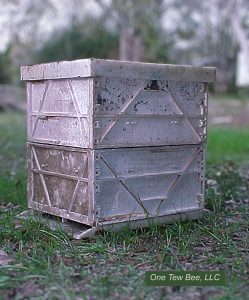
Figure 1
An old, soiled Kelley Plastic Hive, circa 1980.
There it was – a bee hive made entirely of plastic[2]. How modern! While I was dedicated to woodenware, this prominent supply company was seriously delving into plastic rather than wood as hive building materials. Though the Kelley Company maintained its wooden hive production capabilities, it was intriguing that heavy-duty, plastic hive equipment was also offered. This was a major bee supply company manufacturing plastic equipment and I admit that I was influenced by their plastic inventory offerings.
I recently spoke with a Kelley representative
A long time representative of the Kelley Company said that all the plastic hive components were manufactured for many years by several different plastic molding companies in Indiana and Arkansas. The sole piece that remains in production today is the outer cover. After so many years, why did this kind of equipment phase out of their catalog?
Through the years, the plastic molds aged and began to show wear, production companies changed, and beekeeper interest in this style of hive waned. Over time, the hard plastic hive components were dropped from the catalog.
My experience with the Kelley plastic hives was more positive than negative. Yes, the hive equipment did not “breathe” and needed more winter ventilation. Some of the pieces such as the inner cover, would slightly bow at the hand-hold spot in the middle of the inner cover. Later models of the plastic inner cover had support points to address this issue. Bottom boards also deflected some, but that issue, too, was rectified.
The equipment was rugged and weighed about the same as a comparable wooden hive body. The plastic equipment did not require painting and was wax moth and termite resistant. Since the frames were generally made from wood and beeswax, it seems to me that the bees readily accepted the plastic hive body components. Lastly, as I recall, the selling price was similar, too.
As I write this, I wonder if this plastic equipment – or any plastic equipment for that matter – could be sterilized if American foulbrood was found? I can’t answer my own question. Certainly, plastic could not be scorched with fire as has been done with wooden equipment.
My alarms are sounding
This article is not developing along the pathways I anticipated. I have mental alarms going off. Increasingly, in this piece, I am flirting with the concept of providing reviews for plastic equipment use in my apiary. That is not my intent, but how do I describe one product that I own and not mention the others that I also use? So here I am – getting in deeper and deeper as I write about plastic bee hives.
Other plastic equipment in my apiary
I presently have – and use – plastic hive components from Mother Lode, Beaver Plastics, and Bees Forever.
Mother Lode Products[3]
I have used a couple of UV Stabilized Polypropylene hive bodies from Mother Lode Products for several decades. What can I say? My pieces of this equipment have sat outside without maintenance or paint for all those years. The hive bodies have been consistently rugged and stable. The bees seem okay with them, and wax moth and carpenter ants have not been a factor.
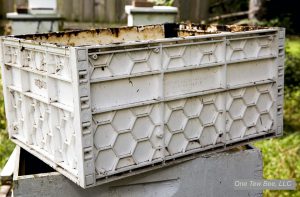
Figure 2
A decades-old Mother Lode plastic hive body.
The R-Value insulation rating simply has to be low. The plastic is nearly translucent at its thinnest points. To compensate, on their web page, the company refers to insulating panels for winter use, but I have no experience with that equipment. I post no recommendations, but after all these years, I have no complaints with my pieces of this equipment.
Beaver Plastics and Bees Forever
Two other types of equipment that have been in my apiary for many years are from Beaver Plastics [4] and Bees Forever[5]. The Beaver Plastics design is thick polystyrene, while the Bees Forever design, like the Mother Lode Products is hard plastic.
Both products are produced as a single piece molded plastic. That design generally increases shipping costs, but there is no assembly time required. The Mother Lode equipment was shipped flat so it required simple assembly.
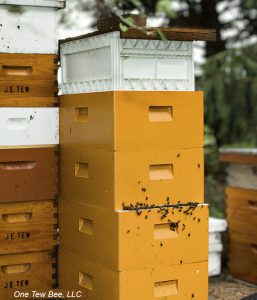
Figure 3
Two types of plastic bee equipment on the same colony (Bees Forever on top and Beaver Plastics on bottom).
Bee Max and Lyson polystyrene hive equipment
Bee Max[6] and Lyson[7] are both manufacturers of plastic bee hive systems. I do not have experience with either of them, but they are both readily available in the bee industry.
Readers, plastic equipment supplies, and abundant styles are available worldwide. Earlier in this article, I indicated that my alarms were sounding. That is still the case. With so many options and so many suppliers, I will most likely get something wrong here. The reader will have to talk to beekeeping friends and peruse the beekeeping equipment internet to make a final decision on this subject.
Bee Box[8] from Paradise Honey
I wish I could write that I had specific reasons, but honestly, I purchased enough equipment for two hives and a queen mating nucleus hive manufactured by Bee Box from Paradise Honey for mundane reasons. I made the decision to purchase this particular model simply because it was available at the moment, I had my truck with me, I had decided to purchase some polystyrene equipment, and the company would take a credit card. After several seasons of use, all has gone (mostly) well. I have used this equipment for several seasons and am comfortable providing the following conversational points.
Applying glue to joints is required
Though this unit was easy to assemble, glue must be used at the time of assembly. The same glue used to assemble wooden equipment is appropriate for assembly of this thick polystyrene equipment.

Figure 4
A cracked joint. My fault. I should have applied glue at the time of assembly.
I was eager to get bees in some of my new-fangled equipment so, without gluing, I snapped one deep together and got a colony established in it. As time passed, the joints on that unglued deep opened a bit, and the bees quickly filled those crevices with propolis. Now it will be difficult – short of complete disassembly – to make needed changes and correctly apply the glue. My lesson learned – apply glue at the time of assembly.
Painting
After assembly, I used my small airless spray paint equipment. Brushing the latex paint on would certainly have been fine, but I had the spray equipment, and it was faster than brushing. I applied two coats. On the hive bodies and supers, I taped off the contact points where the hive tool will be used. I did this not because it was necessary, but primarily because it made the final paint job looked nicer.
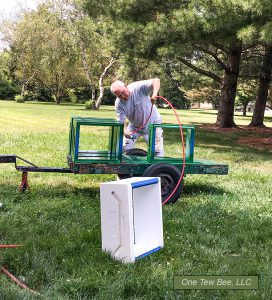
Figure 5
Painting polystyrene hive bodies with latex paint. Note blue tape application.
After beginning to use the equipment, I had problems with the paint sticking to mated surfaces of the hive bodies. I sense that this was a paint issue more than an equipment issue. I waited a couple days before using the newly painted boxes, but they still stuck together and pulled some of the paint off when I later separated the boxes. What to do the next time? Possibly coat the broad painted edges with beeswax or simply do not paint the edges at all. Any suggestions?
Hive tool use
Hive tool use must be modified – particularly when removing outside frames. If I used my hive tool to pry out a frame near the side wall, I could unintentionally put pressure on the glued corner joint. Traditional wooden equipment could easily withstand this corner stress, but when using polystyrene, more care is required. In fact, I did break a joint that connected the front with the side. I referred to this incident above.
Maybe I should have used more glue to strengthen the joints, but what I have been doing that works very well is to use a “frame Grip.” First, I break the frame free. Then using the grip with hive took assisting as needed, I remove the first frame.
Overall, when handling a full deep of bees and honey, I had a sense that this box would not withstand rough treatment or being “racked” by stressing the load on the corners. Just knowing this is enough to handle a full polystyrene box differently than I would handle a wooded deep hive body.
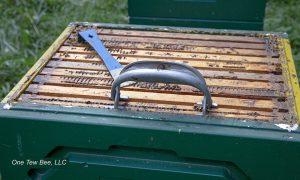
Figure 6
A frame grip and a hive tool used to remove frames. The hive tool can only be used at yellow surfaces. Note some of the green paint pulled off at the corners.
Bees and animals gnawing
I knew that under some conditions, bees will gnaw and chew the polystyrene surface and corners. To help forestall this potential problem, I chose to paint the inside of my equipment with latex paint. Others may not want to paint the inside and I understand that. Paint the inside or not – that will be your call.
Even so, most likely at some point bees and or animals are going to have a chew on this plastic. But chewing animals will also chew on wooden equipment. I consider animals chewing the equipment just to be routine “wear and tear” but what about the bees occasionally gnawing on the equipment? I have wondered if coating the inside of the polystyrene equipment with beeswax would help? (Straight up – let me say that I really doubt that I will ever try that. Too much work. If you do, I hope you will let me know how it worked out.)
Of course, under failed conditions, wax moths will chew up anything. No surprises there, but I did have some unexpected challenges having carpenter ants that constructed nests inside the thick walls of the bee boxes. They were not difficult to shake out, but the equipment was blemished by their activity.
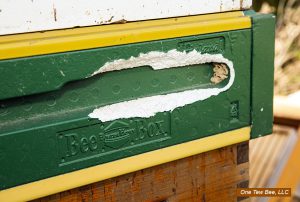
Figure 7
Animals gnawing on plastic equipment. Squirrels?
The good points
Insulation – no doubt about it. The thick walls insulate the sides and ends of the hive. To an extent, both the bottom and the top are insulated, too. Brood may be put in combs along the side wall if the colony is populous, and the brood nest is crowded. This nearly ever happens in simple wooded hive bodies.
I cannot yet say that it was wildly helpful during winter, but all other things being equal, I would expect the insulation effect to be significantly helpful. Adequate ventilation is important.
The equipment fits together nicely and, at least with the equipment I am using, I can readily interchange wooden equipment with the plastic equipment. The equipment has a snug fit and once propolis is added, the unit becomes a firmly meshed hive.
Once painted and cured, the equipment requires few concerns. A positive point with no other real place to post it is that the top feeder, once painted and installed fits snugly and is water tight without any seepage. A top feeder is shown on the polystyrene hive in the photo.
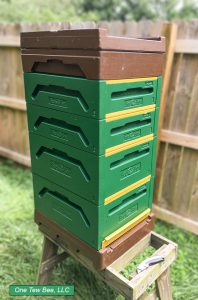
Figure 8
A polystyrene hive with a top feeder.
So, now what?
Should I use plastic equipment, or should I never use it? As is so often the case in beekeeping, the answer to that question is purely your call. I explained why I have primarily used wooden hive equipment, but the plastic equipment experience adds variety to my apiary. I like the diversity, but I truly like the smell of freshly milled pine, too.
I always appreciate you reading, thinking, and communicating with me on these subjects. It’s how we all grow. Thank you.
A bit of a discussion on this plastic hive subject
There is a discussion on pros and cons of plastic equipment, albeit a bit dated, at: https://www.beesource.com/threads/advantages-and-disadvantages-of-polystyrene-hives.320176/

Dr. James E. Tew
Emeritus Faculty, Entomology
The Ohio State University
[email protected]
 Co-Host, Honey Bee Obscura Podcast
Co-Host, Honey Bee Obscura Podcast
www.honeybeeobscura.com
Footnotes
[1] The Walter T. Kelley Company is now affiliated with Mann Lake Bee and Ag Supply, https://www.mannlakeltd.com/catalog/ [2] At that time, the frames were still wood, and the foundation was beeswax sheets. Frames and foundation were not made from plastic. [3] Mother Lode Products. https://www.motherlodeproducts.com/ [4] Beaver Plastics. https://workerandhive.com/products/beaver-plastics-polystyrene-brood-box [5] Bees Forever. https://www.facebook.com/people/Bees-Forever-Plastics/100066450133863/ [6] Betterbee. https://www.betterbee.com/beemax-hive-kits/blk1-beemax-light-weight-kit.asp [7] Lyson. http://lyson.eu/ule-styropianowe/5444-amercian-langstroth-bee-hive-8-frames-roof-2-x-body-bottom-not-painted.html [8] Blue Sky Bee Supply. https://blueskybeesupply.com/hive-components/polystyrene-hives-components/ ]]>By: James E. Tew
“Hey, just combine them”
Combining colonies is a common procedure. As beekeepers, we do it all the time. Yes, we do it and we freely tell other beekeepers to do it. “Hey, just combine them.” Recently, in another piece I was writing, I made the following comment, “Any colonies that don’t take the new queens (or are weak) should probably be combined with another colony.” I was writing this statement in support of Fall Management protocols. As is so often the case, I made no recommendations as to how small the sickly “combinee” should be, nor did I make any reference to the population size and condition of the larger colony, the “combiner.” This fluidity is what I am exploring in this rambling article. Combining colonies is a very relaxed management recommendation.
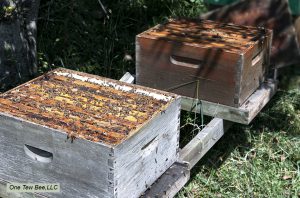
Figure 1. The upper, weaker colony will be combined with the lower, stronger colony.
Not a natural procedure
Wild colonies die all the time. (At this point, I tried to find a generalized citation for just how often wild nests die. One was not readily available. Imidacloprids, water availability, and varroa predation were some of the reasons that feral colonies died. So, I will just leave it at, “Wild colonies die all the time.”) Colonies do not combine in nature; the weak colonies just die – or at least languish until they do die. (If this were a live presentation, I would expect a competent questioner to ask, “Do bees from dying colonies ever drift to more populous colonies?” That would be a good question, and I would not have a ready answer. I would most likely respond, “Probably, but I don’t know for sure.”) Robbing from more populous colonies is normally the coup de grâce for undersized colonies.
In beekeeping manipulations, we do these oddities all the time. Beekeepers collectively call these manipulations “colony management.” A wild colony does not go searching for a new queen outside its own colony. They always grow their own from their own brood.
In our human world, beekeepers show up in the bee yard with a caged queen – that has never been part of the colony to which she is about to be “introduced.” We then try to coerce the colony to accept this interloper. Or could I say be that the foreign queen is to be “combined” with the queenless colony? After the required introduction time, the queen is amalgamated (or combined) with the colony. The acceptance of a foreign queen is as unnatural as two feral, weakened colonies deciding to combine their meager resources, and become one. That’s not going to happen. They are both going to die before Winter’s end.
Beekeepers, when I think about it, bee management, in general, is just a long list of “oddities” that we do for (or to) our bees that they would never do for (or to) themselves. For example, wild colonies do not live in apiaries (groups), they don’t swap or share brood, they don’t add more space when their cavity is filled (supering) and they are not crazy about straight, standardized combs. So, no – combining colonies is not something that happens in nature, but it is something that happens in bee management – and it’s an old, useful procedure.
“Hey, just combine them” – again
Think about it. What are we actually accomplishing when we combine a weak colony with a stronger colony? Bottom line – we are giving the stronger colony the problem that we probably caused in the first place.
When considering laying workers, let’s look at this situation from the perspective of the stronger colony. Out of the clear, blue sky, in ways that would never happen in nature, a functional and staid colony suddenly has ten frames added to it – with some of the frames containing laying worker brood, and supported by a cadre of old, physically depleted workers. Within the hive, I have no idea how the bees sort this mess out, but I do have some guesses.
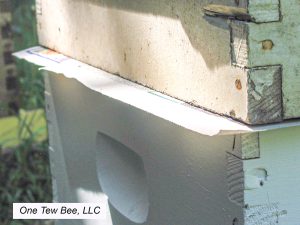
Figure 2. A newspaper sheet used to combine two colonies.
A series of assumptions
In ways unknown to me, I assume that healthy worker bees, from the receiving colony, perceive the laying worker eggs and brood and either eat or otherwise remove the haploid brood from the combined colony nest. I also assume that the adult laying workers most likely die of old age or from internal colony abuse. Until their death, any eggs that they may have continued to lay, will be – once again – destroyed by healthy worker bees. The undersized drones really have very little hope of any kind of success (I assume). In general, the undersized drones are just going to die. (In past articles in which I discussed laying
workers, I postulated that these puny drones were the last effort of the laying worker colony
to dispense its genetic strain into the greater gene pool. Regardless, these undersized drones – last effort or not – do not stand much of a chance for success.)
So yes, as bee colony managers, we all know that a “suitably strong” combiner colony can contain and clean up the failed situation. But… was the receiver colony improved or advanced by having to spend its time and energy getting this situation under control? I think not.
I speculate that two or three things happened in this laying worker scenario: (1) We beekeepers did not have to watch the bees from the smaller colony die, (2) we got our deep hive body back with ten frames all nicely cleared out and ready for reuse, and (3) the stronger colony protected the laying worker combs from wax moths. I speculate that rarely is the stronger colony made even stronger by the addition of a laying worker colony or any weakened colony for that matter.
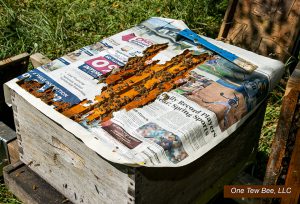
Figure 3. Newsprint being removed 24 hours later.
What caused the weakness?
It is important to the beekeeper manager that they know the reason for the smaller colony weakness. For instance, during this past Spring season, I had a beautiful colony that seemingly would not stop swarming. While I got two swarms from that colony, I don’t know how many others got away. But by the time the swarming impulse waned, the once-beautiful colony was only a weakened shadow of its former self. Presently, I have no plans for combining this colony with another, but I know why this unit is now a smaller colony.
Queens age and their output declines. The season passes and worker population declines some. There are many reasons why a colony will be less than what it was just a few months ago. Don’t feel pressure to combine just because the colony’s population fluctuates some.
Please consider this – Important
Do not combine colonies that are diseased. Be able to recognize American foulbrood (AFB). Isn’t it ironic that beekeeper transmission is the main way AFB spreads? Thankfully, AFB is reasonably rare, but stunningly persistent. Make a major effort not to spread this disease – or any other – within your bee yard. If you are uncertain about any disease or another in-hive pest, gather more information or get the opinion of others.
Though off the subject, a comment on making splits is pertinent at this point. Do not make splits or take bees for colony increase from colonies that are diseased. Both combining colonies and splitting colonies are two common times that beekeepers can spread diseases in their apiary.
The timing
If you are combining colonies, the chances are excellent that a major nectar (or pollen flow) is not ongoing. Before a flow begins and during a flow, beekeepers would be in the “give the weak colony a chance” mode. As the food-gathering time passes and it becomes clearer that the colony is not going to thrive, then the concept of combining them with another colony becomes the standard option. So, what else is timely at this point? Robbing behavior.

Figure 4. A colony with a brood pattern like this should be destroyed – not combined. This frame has American foulbrood.
In previous articles, I have seemingly had robbing behavior epiphanies, and I waxed long and then even longer in some of my earlier articles3. But based on my thoughts on robbing, if there is no flow ongoing, I can assure you that foragers from large colonies are not just sitting in the hive awaiting the day when once again flowers abound. Nope – they will be nosing around neighboring colonies checking their defenses.
At this point, let’s say that you begin the combining process. No flow is occurring, and you are opening two colonies – one very weak – and causing defensive confusion in both colonies. This situation would entice robbers to check out the confusion at the combined colonies. In the bright light of harsh reality, many times we would not be heartbroken to have the smaller colony robbed and killed. Its fate was sealed anyway, but we most likely did not want the healthier of the pair to also be attacked. That’s the colony that deserves our worry.
What to do? In a perfect world, we would move the colonies to a different yard. Then there is the reality of moving two colonies at least three miles away and the related problems that are associated with moving colonies. That is a different article. All this effort – all of this typing – all of this thought – is for a small bee colony that is actually nearly dead already. It’s what we do. We’re bee keepers, not bee killers.
Colony combining techniques
Shake the bees out of the equipment
The combining technique typically varies with the population of remaining bees in the dying colony. If there are only a few – maybe 200 to 300 bees – many beekeepers just shake them out of the equipment near another colony. They may or may not find their way into the nearby colony. We knew that would happen when we used this technique.
Newsprint sheet barrier
If – for whatever reason – there are more bees – maybe a thousand or more – a simple sheet of newspaper atop the stronger colony of the two is enough of a confusion barrier to seemingly distract the bees as they remove it from the combined hives. A few slits or a few punched holes through the newsprint is supposed to inspire the bees to remove it more quickly. The weaker colony is put on top of the lower, stronger colony. As per the title of this article, this is not a precise procedure.
A puzzlement… I wonder what happens between two opposing bees as they penetrate the newspaper and greet one another for the first time. Do they both smell and taste like newsprint? Do some newly introduced bees actually confront each other in an aggressive manner and beekeepers just do not see it? Rather, are the bees being combined defeated and placid? It does appear, that as newspaper is removed, the bees begin to amicably coexist. It’s a puzzlement to me that a simple piece of paper is enough to alter fundamental innate bee behavior. However, it appears that it does.
Smoke
Use smoke on both colonies. After removing the queen, if she is still present, shake the bees from the weaker colony onto the open top bars of the larger colony. Use appropriate smoke the entire time. Close the colony and remove the now empty equipment from the area. Then, hope for the best.
Sugar syrup
Use thin scented sugar syrup in the same manner as smoke. Spritz both colonies. Remove the queen from the weaker colony and while spritzing the scene, shake the combined bees onto the top bars of the stronger colony. Then, maybe another spray or two and close the colony up. Again, it is important to remove the empty equipment from the area.
Confinement
Using a package bee funnel, shake equal quantities of bees from both colonies into a package cage. Feed the combined bees enough to keep them alive for a few hours. Shake the bees back onto the top bars of the stronger parent colony. What you were trying to accomplish with this procedure was to have the foreign bees have the odor of the colony with which they were being combined.
When releasing the bees, maybe use a bit of smoke or some sugar syrup, but this step is not required. Close them up, and again, hope for a bit of good luck. To me, this process seems like a lot of work, but the procedure is in your management tool box if the need arises.
Everything is a variable
When using this concept of uniting colonies, there are numerous variables. For instance, how many small colonies do you have to combine? Are they tiny colonies or do they have respectable populations? Maybe you raised some queens, and you now have depleted nucs that need to be emptied. Maybe you picked up small swarms that did not grow to a suitable size. I’m speculating. I really don’t know why you have these small colonies, but you do have them.
Experienced beekeepers have indicated that they like to leave their good colonies alone and only perform combining procedures using “average” colonies as the receiving colony. Possibly, the average colony is helped by the additional bees. The management point is – do not disrupt your best colonies with these combination procedures. Also important, do not take excessive amounts of brood from good colonies to subsize combined colonies. Always remember that you are essentially working with dying bees.
One quirk without a category in this article
There is a situation when bee colonies – in a way – do combine themselves. Many years ago, when the Africanized honey bees (AHB) invasion was a major beekeeping issue, scientists reported that small swarms – headed either by mated or unmated AHB queens – would alite on a bee hive and invade the European stock within the hive. The invading bees would usurp the colony’s European queen and take over the colony. Were these colonies combining or were the European colonies simply being invaded? I am not aware of any recent reports of this happening, but just so you know…
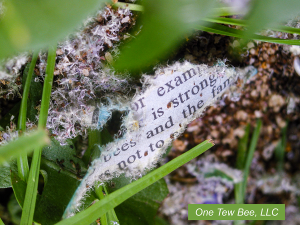
Figure 5. Frayed pieces of newspaper in front of colonies being combined.
In most instances
After thinking and writing on this subject, I sense that in most instances, when I have combined colonies, I was really just trying to get rid of the aged bees and get my empty equipment back. Additionally, I was trying to keep wax moths from overtaking the unprotected combs. I can’t think of a single instance when I ever combined a colony and then truly believed that I had a stronger colony because of the combination procedure.
This process seems to be a very useful way to eliminate bee colonies that simply did not make the grade. When keeping bees, you win some and you lose some. Combining bee colonies is simply a management tool. Use it when you need it. The bees will sort things out.
Dr. James E. Tew
Emeritus Faculty, Entomology
The Ohio State University
[email protected]
 Co-Host, Honey Bee Obscura Podcast
Co-Host, Honey Bee Obscura Podcast
www.honeybeeobscura.com
]]>
By: James E. Tew
Beekeepers slowly grow to accept the obvious
If you read any bee book, beekeeping is made to look precise – predictable. In reality, it is anything but. Through the passing decades, innumerable times, new beekeepers have plaintively cried to me (and you), “I put on the supers, but they didn’t use them.” “I removed the cork, but the bees still have not released the queen from that little cage thingy.” “I put on a feeder, but the bees didn’t take the syrup.” Or “I put on another brood chamber, but they still swarmed.”
Bee management is not precise. It never was. When we are new beekeepers, we try to treat the craft with precision, but we are continually rebuffed by the bees and the decisions that they make on their own. The book says, “Do these things, in this order, and your bees will be fine – most of the time.” Over time, the ever-evolving beekeeper begins to accept the ambiguity of the craft. Whatever common management procedure that we are doing is probably the right thing to do – most of the time. Our general management recommendations are always best guesses. They always have been.
But still, we never miss an opportunity
Colonies on scales
But we never miss an opportunity to try to add some precision to our management systems. Scale colonies and their related apps are a great example. You can tell a lot from what is happening with a colony that is on weight scales. Scale colonies’ data yields actual numbers. You can tell when a nectar flow is ongoing and when surplus honey is being stored. But you are only recording what happened either by natural forces or by bees making their own survival decisions. We’re not really controlling anything. “Well, it was a cold, wet Spring this year. The bees are late.” “Humm, clover is in full bloom. Why are the bees not putting up more crop?”
In this case, data gathered from the scale colony helps us improve our future guesses – but they are still just numerical estimations. Just so you know, I heartedly support the use of scale colonies or other weighing devices on some of our colonies. Even though they are still estimations, over time, scale weight data significantly improved our ability to predict and schedule future management events.
Requeen regularly
Change the queen on a regular basis. Yeah, right! That’s in every general bee book seemingly ever published. It’s a common recommendation made by authors who will not be paying for the replacement queens or installing them. Even so, the perpetual recommendation has been to requeen every other year. Apparently, the prevailing opinion is that a new queen will not swarm during her first year on the job, and the bees will not be superseding during the nectar flow (Personally, I have commonly had late season swarms from packages or splits that outgrew their brood nest areas. I am reasonably comfortable writing that if the brood area is consistently crowded, even a first year queen cannot suppress the swarming characteristic within the colony. In earlier articles, I whimsically referred to these late swarms as suicide swarms. They had no chance of surviving the upcoming Winter. But oddly, the parent colony was going to face extreme challenges, too, in getting the new queen mated so late in the season. I offer the comment here that these late season swarms are truly bad for the general survival of both the swarm and the parent colony. Why would a colony do this?).
So, do you see? As bee managers, we try to get ahead of this swarming/superseding thing by requeening every other year. In textbook beekeeping, the replaceable queen is probably already doing a marginal job and needs to be replaced. In yet other textbook beekeeping worlds, queens are readily available and are affordable. Importantly, in the perfect world of textbook beekeeping, hypothetically, I am an accomplished bee colony manager, and I am able to perform this queen-replacement event with confidence and certainty. So, do you see? We put a specific time interval on queen events – events that are very unpredictable. The book said to do it. So there, we do it.
Replace combs every three years
I put the three-year stipulation in the opening header to this section. Some authorities’ guesses are every five years while other pundits offer the classic “as needed” designation. In my earliest bee years, I was taught that combs could be used indefinitely. In my bee classes, I was told that there were combs at Cornell University that were thirty-five to forty years old. They would be even older now.
My first beekeeping professor told my class that the beauty of managed beekeeping procedures was that more honey could be produced because the bees were required to produce less wax. It made beautiful sense – or so it seemed. Finally, here was something in beekeeping management with no time designation.
At the time I was being taught this irrefutable fact of comb refilling, I would drink an occasional Coca Cola from a six-ounce “returnable” bottle. That soda bottle reuse procedure is one that many current younger people know nothing about. There was an entire infrastructure for returning the bottle to the bottler and having it subsequently refilled. If you wanted to take the bottle with you, you paid a few cents for it. You then owned the bottle and could sell it back later – for a few cents.
This returnable soda bottle procedure was frequently compared to beekeepers returning wax combs to awaiting bees. Returning combs to the bees for refilling was just like glass bottles that were being returned to soda companies for refilling. Yet today, most beekeepers are still returning combs to the bees, but they now drink from disposable bottles or cans. Is the lifetime of reusable wax combs truly opened ended? Is it time for us to stop reusing beeswax combs so long?
Well, how long should combs be used? Oh, I don’t know – maybe three to five years or just replace “as needed.” I’m back to where I started on this subject. I promise that I don’t mean to annoy anyone who is reading this, but my combs come and go with just common usage. No doubt I have some that are too old, but alternatively, I have recycled combs that only had a couple of years use when they were retired. There are all kinds of reasons that a comb is retired other than toxic compound accumulation. Some examples are wax moth damage, comb disease, mouse damage, top bar pulled off or aberrant comb construction (A beekeeper friend of mine likes these old, dark combs for use in swarm trap boxes. He feels that these old combs are highly attractive to homeless bee swarms).
Bottom line here is that there are no clear rules for something as simple as wax comb replacement. You, the beekeeper, must deal with the indecisiveness of the issue. It’s just another example of the imprecision of beekeeping.

Figure 1. A proactive homeowner helping insect pollinators.
Hey, the nectar flow is going strong – or not
Beekeepers, why is it that so many available blossoms, on beautiful Spring days, have not a single bee – of any species – anywhere near them? I wince when I hear how dramatically the overall insect population has declined. I can readily observe the “bug” population decline by the significantly reduced insect population at the outdoor light on my back deck or on the windshield of my truck after a drive to a distant bee yard. I have written in previous articles about the thousands of lightening bugs in my backyard in the 1970s but now my yard only supports a few hundred. Time and again, I read that “Something must be done about the insect decline!”
So, I participated in No-Mow-May, and I did not cut my grass (or spray) for most of May. I had dandelion blooms that were approaching ten inches tall, and I had them by the thousands. I had eight hives just a few yards away, but what I did not have was foraging bees on these dandelions. With no science nor accurate counts, I roughly estimated that there was one honey bee – frequently a pollen collector – per approximately five-hundred blooms. By the time you read this, this season’s clover crop will have bloomed and gone, but for me, I am still anticipating it. I can guarantee you that my upcoming clover honey crop – just like the dandelion bloom – will be disappointing. These two plants, and many others, are listed as major food plants for bees. If they are so lucrative, why are there so few insect visitors on these plants’ blooms?
Previous experience, the annual calendar and data from scale hives, are three cues that will have alerted me to the coming of the seasonal nectar crops. Predictably, clover blooms will be like dandelion blooms – thousands of blooms and only a few hardworking foragers. In the imprecise world of beekeeping, I will feel that there has not been enough rain – or alternatively – too much rain. Maybe it has been too cool, or something is off with my fertilizer application. Could be the wrong variety of clover – and the classic – there’s always next year.
Books and information sources will correctly list the “approximate” blooming dates for the plants my bees love. Please help me here – am I totally wrong? I have not seen the classic nectar flow filling new combs in a couple of decades. I’m remembering those nectar flows of old when beautiful, new combs were seemingly drawn overnight. I’m remembering when I removed a new, snow-white comb frame from the super and turned it horizontal for a better look – and I would have copious amounts of water-thin nectar rain on my shoes.
Don’t get me completely wrong. I still get some honey from my bees, but I tell you truly that I have not seen abundant, thin nectar in my colonies in many years. Is this only happening in my immediate area? I fear that this is just my modern, weed-free, Midwestern corn, wheat and soybean ecosystem. The roads and lawns here are also weed controlled, so this occurrence may just be my lot. If you still get the stereotypic, intensive nectar flow, I would enjoy your correspondence on the subject – if only for me to reminisce.
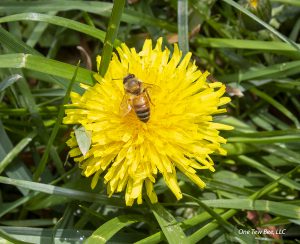
Figure 2. Why do so many dandelion blooms NOT
have pollinators visiting?
The very opposite aspect of this imprecise discussion – honey bee precision
While much of bee management recommendations may not be precise, many aspects of honey bee biology are stunningly precise – stunning. For instance, the orientation mathematics that bees use is… may I use the word again… stunning.
Frankly readers, this will be a short discussion section because the bees’ inborn ability to calculate, orient and construct are far beyond my ability to expound and discuss. For instance, scout bees leading the hoard to the new home site. How do they do that? That lone water forager bee that can find the tiny amount of water leaking from my water hose and then send others to it. How do they do that? The precision with which bee construction workers can build new hexagonal combs or how bees that are essentially blind in the dark can so easily find the successful forager that is presenting a mathematical grid (the dance) to direct recruits to the new home site or to a food source. Again, how do they do that? This Astounding List of bee innate abilities is nearly endless (In fairness, it should be said that many, many life forms possess novel behaviors and abilities – not just honey bees. But again, in fairness, honey bees are the life form that we are presently discussing).
To academically make my point, I offer a note (Frank, Adam. October 1997. Discover Magazine. Quantum Honey Bees. https://www.discovermagazine.com/planet-earth/quantum-honeybees) presented several years ago in Discover Magazine, and then I offer a second reference (Shelomi, Matan. https://www.quora.com/What-is-the-current-state-of-research-on-Barbara-Shipmans-findings-regarding-Quantum-Mechanics-and-the-Honey-Bee-waggle-dance) that refutes the concepts of the researcher’s original comments made in the magazine article. This academic interaction is beyond the scope of my present article, but this advanced discussion touches on the complexity of the bees’ natural ability that they use in their currently unexplained world.
This esoteric discussion in the technical beekeeping literature clearly makes the point that, “We don’t know what we don’t know.” I have made no serious effort to explore all avenues of this ongoing interaction that presents advanced concepts in honey bee mathematics and quantum physics – if such a type of mathematics and quantum physics even exists.
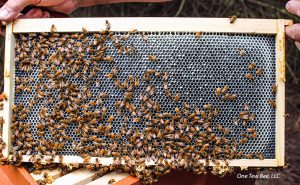
Figure 3. Look beyond basic bee management to the complex biology and mathematics quietly shown in this photo.
The imprecise precision of beekeeping
I speculate that our myriad questions and odd events in beekeeping are because our true understanding of honey bees and their ways is presently only at the elemental level.
Yes, it’s true. All of us are only beginner beekeepers – some more than others.
I can’t even tell you why Summer bees perform the washboard behavior or if forager bees know the existence of neighboring colonies so they can rob from them if the need arises. How do bees find water sources – by smell? If so, it must be a very powerful sense they have for I have had them find very small water sources. How do scouts find new home sites? Sight? Compared to my vision senses, what does the world look like to flying bees? Questions seem endless.
From intellectually afar, it would appear that bees, indeed, do have a remarkably precise lifestyle. This lifestyle only appears imprecise to us – humans – because we are still learning and exploring the tools and abilities that bees have that are fully foreign to us. We have only begun to understand.
Thanks for reading
Thank you for reading this piece. I always appreciate your time, but more importantly, thank you for thinking.
Dr. James E. Tew
Emeritus Faculty, Entomology
The Ohio State University and
One Tew Bee, LLC
[email protected]
Honey Bee Obscura podcast
https://www.honeybeeobscura.com/
 https://youtu.be/3MOFqQjNtdA
https://youtu.be/3MOFqQjNtdA
